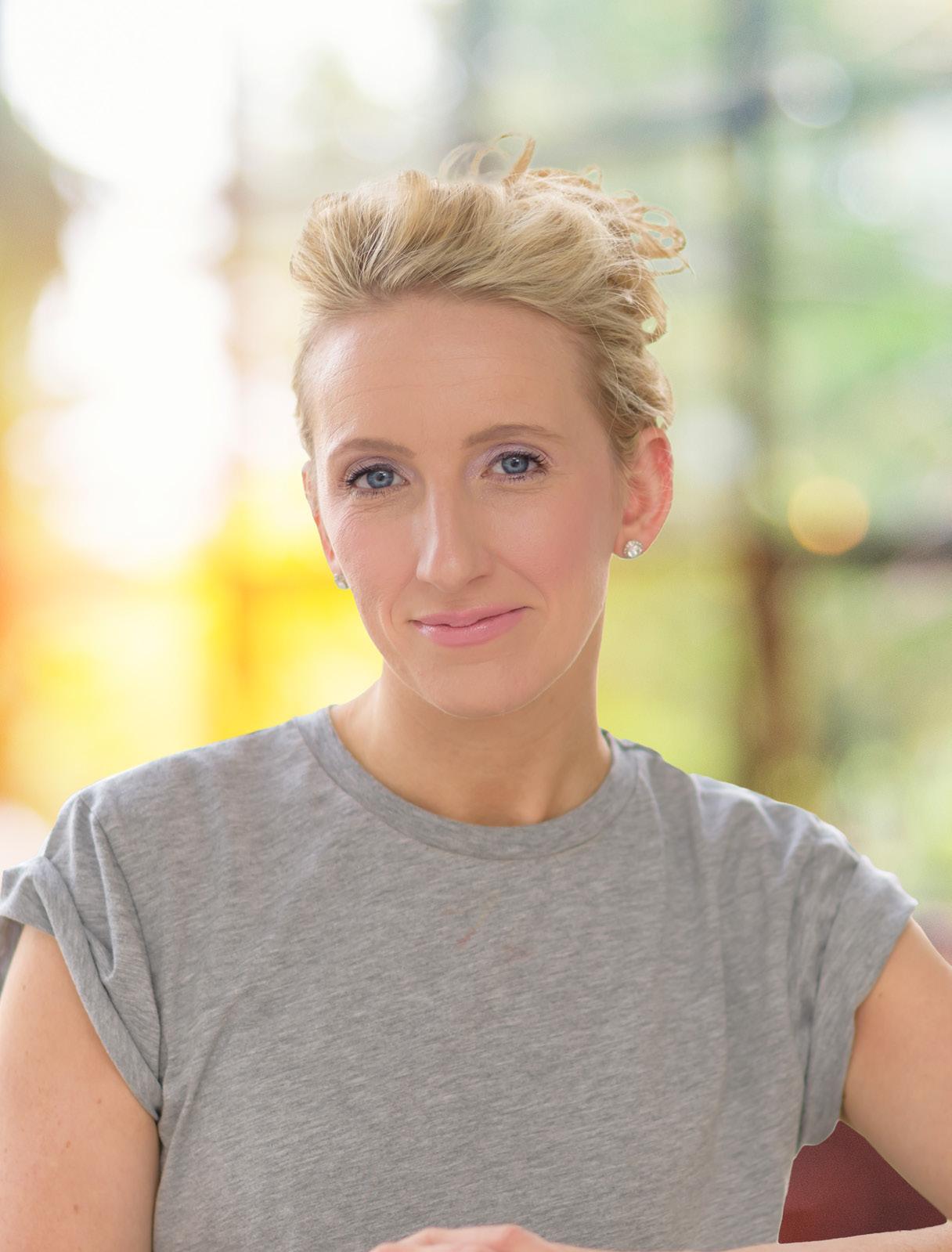
INSIDE: ELITE WOMEN 2024
Highlighting the industry’s finest






Industry Icon




The rise of The Mortgage Mum

Champion of the Mortgage Professional
SARAH TUCKER
roundtable debate explores a dynamic and rapidly growing sector – see pages 24-28
WHY AGE IS ALL THE RAGE Our















WITHOURUNDERWRITERSTOFINDA FLE X I B LE SOLUTION FORTHECLIENT.
Mr and Mrs Smith, aged 72 and 73, were mortgage free. They wanted to raise capital of £220,000 from their property worth £400,000; £80,000 for home improvements, and £140,000 to gift to their son and daughter.
Both had a state pension amounting to £20,000 between them. Mrs Smith has a fixed private pension of £4,000, whilst Mr Smith has a pension pot of £500,000 – but he hadn’t drawn down on it because they hadn’t needed to.
Most lenders the broker had spoken to would not consider the pension pot at all because it had not been drawn down or at most would consider 3-5% of it.
Our flexible criteria allowed us to consider 90% of Mr Smith’s £500,000 pension pot – equating to £450,000. We were able to o er Mr and Mrs Smith a mortgage term of 10 years and divide the allowable pension pot of £450,000 by the 10 years, giving them a usable income of £45,000.
Taking this income into account, plus the desire to take it on an Interest-Only basis, we were able to o er them a fi ve-year fixed rate mortgage.
COULD WE HELP ONE OF YOUR CLIENTS? SEE JUST HOW FLEXIBLE WE CAN BE! VISIT intermediaries.familybuildingsociety.co.uk
CALL US ON 01372 744155
OR EMAIL mortgage.desk@familybsoc.co.uk
A BROKER CAME TO US WITH A COMPLICATED LATER LIFE LENDING CASE HE WAS STRUGGLING TO PLACE. WE WERE ABLE TO HELP BY WORKING CLOSELY FAMILY
KT17 4NL
L E SOLUTI O NS F O R LATE
LIFE LENDIN G
FLEXIB
R
BUILDING SOCIETY, EBBISHAM HOUSE, 30 CHURCH
SURREY
Family Building Society is a trading name of National Counties Building Society which is authorised by the Prudential Regulation Authority and regulated by the Financial Conduct Authority and the Prudential Regulation Authority. National Counties is on the Financial Services Register. Firm Reference Number 206080.
ST, EPSOM,
Managing editor
Paul Lucas
paul.lucas@keymedia.com
Editor Simon Meadows simon.meadows@keymedia.com
Senior news writer Rommel Lontayao rommel.lontayao@keymedia.com
Commercial director Matt Bond matt.bond@keymedia.com
Campaign coordinator Raniella Alonzo raniella.alonzo@keymedia.com
Vice president, sales
Chris Anderson
Vice president, production Monica Lalisan
Production coordinators
Kat Guzman & Loiza Razon
Lead production editor
Roslyn Meredith
Art director
Marla Morelos
Designer
Khaye Cortez
President, Tim Duce
Director, people and culture, Julia Bookallil HR business partner, Alisha Lomas-Oliver Chief information officer, Colin Chan Chief revenue officer, Dane Taylor
CEO, Mike Shipley
COO, George Walmsley

KM Business Information UK Ltd
Signature Tower 42, 25 Old Broad Street Tower 42, London EC2N 1HN www.keymedia.com
UK ∙ Canada ∙ Australia ∙ USA ∙ NZ ∙ Philippines
Mortgage Introducer is part of an international family of B2B publications, websites and events for the mortgage industry
CANADIAN MORTGAGE PROFESSIONAL cmpadvertise@keymedia.com
MORTGAGE PROFESSIONAL AMERICA mpaadvertise@keymedia.com
MORTGAGE PROFESSIONAL AUSTRALIA claire.tan@keymedia.com
AUSTRALIAN BROKER simon.kerslake@keymedia.com
NZ ADVISER alex.knowles@keymedia.com
Copyright is reserved throughout. No part of this publication can be reproduced in whole or part without the express permission of the editor. Contributions are invited, but copies of work should be kept, as the magazine can accept no responsibility for loss.
Opportunity knocks

When I was a fresh-faced teenager with a head full of dreams, there was a bold new song getting plenty of airplay across radio stations – Opportunities by an emerging band called Pet Shop Boys. The intriguing lyrics seemed to embody the time:
“Oh, there’s a lot of opportunities
If you know when to take them, you know?
There’s a lot of opportunities
If there aren’t, you can make them
Make or break them
“I’ve got the brains, you’ve got the looks
Let’s make lots of money
Let’s make lots of… money”
Nearly 40 years on and the importance of opportunity holds true, particularly in the mortgage industry. Most of us need a set of circumstances to put us on course to achieving our goals. And so it is that opportunity runs through the pages of this edition of Mortgage Introducer like letters through a stick of seaside rock.
Our cover star, Sarah Tucker, co-founder of The Mortgage Mum, recalls her journey from wannabe pop star to fully fledged industry icon. She believed the opportunity she craved on a TV talent show could lead her to chart stardom. Curiously, it instead gave her the profile she needed to establish a groundbreaking female brokerage. It’s a fascinating story.
Then we examine the opportunities that later-life lending offers to those who all too often believe they won’t be able to borrow in their advancing years. With our roundtable sponsor, Family Building Society, we have brought together some key industry experts for a deep dive into how the market is growing.
In our inspiring profile of Just Mortgages adviser Konstantinos Kepesoglou, we learn how he moved from Greece to make a new life in the UK. The British mortgage industry has given him the chance to build a career he loves.
Finally, Siobhan Holbrook, director at Mortgage Light, looks back to the first deal she ever wrote as she grabbed her moment to become a successful broker.
Enjoy the magazine… and don’t forget to grab those opportunities.
Simon Meadows
www.mortgageintroducer.com SPRING 2024 MORTGAGE INTRODUCER EDITORIAL COMMENT
1





MORTGAGE INTRODUCER SPRING 2024 www.mortgageintroducer.com MAGAZINE WHAT’S INSIDE Contents 4 Market review 9 Advice review 35 Buy-to-let review 40 Protection review 42 General insurance review 44 Second charge review 45 Specialist lending review 10 Industry Icon From aspiring pop star to The Mortgage Mum, Sarah Tucker shares her journey
Special Report Celebrating The Elite Women of 2024 who are driving positive change in the mortgage sector
Interview Paul Roberts on the key role Family Building Society plays in creating lending options for later life borrowers 24 Roundtable Industry professionals give their insights into the rapidly growing later life lending market 30 Broker Focus The Mortgage Stone’s Konstantinos Kepesoglou finds his purpose in life as a broker 32 Sector Focus Growing customer awareness of its benefits is giving a boost to bridging finance 48 My First Deal How Siobhan Holbrook overcame hurdles to help a young Spanish client buy his first home in the UK 2 INTERVIEW: PAUL ROBERTS 22 10 SARAH TUCKER: THE MORTGAGE MUM 32
ELITE WOMEN 2024 BRIDGING IN FOCUS Cover photo: Sarah Tucker, co-founder, The Mortgage Mum
15
22
15
www.mortgageintroducer.com SEPTEMBER 2023 MORTGAGE INTRODUCER
Certainty meets flexibility: A mortgage solution for our times

At April Mortgages we recently launched our 5–15-year unique fixed-rate proposition to considerable media fanfare. It’s not hard to see why our product has become such a talking point.
Certainty and flexibility may seem like odd bedfellows, but the climate for a product that delivers both is now.
Inflation figures in December proved we are not out of the wars. Indeed, global instability is doing as much as anything to prop up prices. The war in Ukraine illustrated what could happen to energy and food prices under such tragic circumstances, and the current reaction by the West to the issues facing shipping trying to pass through the Suez Canal speaks volumes of western governments’ expectations of the economic consequences for western shoppers, especially in an election year.
The Bank of England held interest rates steady in February, and the likelihood is that any cut, if one comes at all, will not feature until the second half of this year. Swap rates have adjusted accordingly with lenders repricing. Going forward, what we can be sure of is that borrowers face more uncertainty, and the appetite for fixed rates will not diminish – not least because 1.5 million households are due to reach the end of their current fixed-rate deals in 2024, seeing mortgage bills rise by an average of £1,800.
All this means brokers’ advice to clients is incredibly important. Wage inflation data makes an interest rate cut seem less likely, and current volatility, the recent holding of rates
and subsequent uptick in swaps, means fixed rates still offer a lot of certainty in a market that is doing nothing to convince anyone one way or another that rates have peaked.
Fixed rates have always played an important role in delivering certainty. But longer-term fixed rates can now perform that important function in the market. Historically, their Achilles heel was always the lack of flexibility for borrowers and the fact that, in essence, long-term fixed rates did not support the intermediary business model.
Until now.
Taking inspiration from our Dutch parent and its success in that market, April does not charge early repayment fees when borrowers sell their homes or repay their loans from their own funds. In addition, as borrowers’ loans decrease, so do the interest rates they pay, because the lower the borrowing, the lower our risk.
But we recognise that addressing borrower concerns is only part of the equation. We believe in long-term relationships with our broker partners as well as our customers. Our mortgages are only available through intermediaries, and we work in partnership with brokers to ensure you receive the same excellent service as your clients and that you are fairly rewarded over the period of the loan for your hard work. This means that our broker partners benefit from income flows that help embed value in their businesses over the long term.
From arranging the initial product to product switches and further advances later on, we will work with our broker partners and reward them appropriately for the time and effort they put into our relationship. When the product period is up, we will always offer the same rates available to new customers and reward our partners for supporting us.
Part and parcel of delivering a new

proposition to market is developing in-depth, sound commercial relationships with our brokers. This means, of course, building slowly and responsibly as we make sure we can meet the expectations we are setting. We have started with limited distribution this year, which we plan to grow in line with our lending ambitions and in step with our proposition as we develop it over time. The key is that delivering service excellence is a cornerstone of our proposition, and we won’t try to run before we have learned to walk. It’s a huge undertaking and one we are working hard on, to broaden and roll out our proposition responsibly.
We are not alone in believing long-term fixed rates offer a solution to the issues of affordability and access to housing. Politicians have been espousing the benefits of long-term fixed rates as a means of broadening the base of homeownership in the country. Whether the market is ready for 25-year fixed-rate deals right now remains an interesting point. Our experience is that 5–15 years fixed represents a time frame everyone can understand and embrace while welcoming the other features that make our fixed-rate term lending so unique. M I
MORTGAGE INTRODUCER SPRING 2024 www.mortgageintroducer.com 4 REVIEW MARKET
Tim Hague Commercial director, April Mortgages
It’s suggested that 1.5 million households are due to reach the end of their current fixed-rate deal this year


Using bridging finance to lock in longer-term opportunities

After speaking with a number of our introducers and various strategic partners over the first few weeks of 2024, it’s clear there are plenty of people across the industry who are looking forward to the next 12 months with growing levels of optimism and confidence – a highly encouraging sign on the back of such a challenging year from a lending, intermediary and borrowing perspective.
Intermediaries have often been referred to as a resilient bunch in the past, but let’s also give them credit for their more recent evolution as a more industrious, innovative and adaptive bunch. This is especially true when it comes to prising open opportunities across the specialist lending market to meet the changing needs of their clients in line with ever-shifting market dynamics and economic influences.
However, identifying these opportunities is not always easy, and this is where it pays to form a better understanding of underlying trends in certain sectors and how, where and when to tap into these prospects.
One area of the specialist market in which the scope and diversity of opportunities continue to rise is in the commercial and semi-commercial property space. This could be through the repurposing of retail property, mixed-use or semi-commercial mortgages, student housing, or a variety of development projects, large and small.
This is evident in the highly insightful Opportunities and Outlook: The Future of Commercial Property report from

Together, which found a strong appetite among commercial developers, investors and landlords who were either exiting or diversifying portfolios to mitigate falling yields and revenues.
According to the report, 23 percent of all respondents felt the commercial market was improving and far more opportunities were being generated; 18 percent said the opportunity to generate more money was high, and 16 percent reported that purchase prices had reduced to allow them to snap up deals and generate new opportunities. Almost a quarter of respondents (23 percent) said student housing offered the most appealing property investment opportunity over the next 12 months. This was followed by housing developments (21 percent) and luxury residential properties (19 percent).
While 29 percent of property investors surveyed were aware that falling property values could make securing lending difficult this year, this was not a factor preventing the majority from capitalising on emerging growth sectors. Nearly one in five property investors (18 percent) indicated that they were most excited to pursue retail projects this year, followed by 17 percent targeting housing developments and 16 percent student accommodation.
From a lending standpoint, 52 percent
of commercial landlords, investors and developers felt that specialist lenders were best equipped to deal with their particular lending needs. Meanwhile, over two thirds (69 percent) of respondents anticipated the amount they would have borrow to support their investment strategy would rise in the next 12 months.
When focusing on a particular sector it can be easy to forget, or in some instances ignore, the impact of other types of finance that can support growth and help convert opportunities. One such form of finance that has long been instrumental for a range of businesses, for purposes ranging from debt consolidation to refurbishment projects and securing future premises –is bridging finance.
This facility can work hand in hand with commercial finance in a similar manner to how it is used across the buy-to-let sector. It can be an effective funding vehicle to help corporate, commercial customers and portfolio landlords snap up advantageously priced investment properties and trading premises within the tightest of time frames and impending deadlines before exiting onto a longer form of finance.
As highlighted in Together’s report, if the commercial market is going to be able to lock in the longer-term opportunities that are undoubtedly out there in both the residential and commercial property sectors, bridging finance will play a critical role in this journey – as will the support of a specialist packaging partner who has the ability to add real value in any commercial transaction. And, after operating in the commercial lending space for over 20 years, this is why we work so closely with so many introducers to deliver commercial and bridging solutions that can meet all their clients’ specialist needs and add real value to their businesses. M I
MORTGAGE INTRODUCER SPRING 2024 www.mortgageintroducer.com 6 REVIEW MARKET
Donna Wells Managing director, Envelop
Bridging finance can play a critical role in helping the commercial market lock in longer-term opportunities
Clients and brokers value the right kind of help in this market

An adviser’s life is one that is rarely straightforward and comes with a lot of responsibility for the clients they help. After more than a decade of a sub-one-percent base rate, the past 18 months necessitated a pretty seismic shift for advisers.
Rate certainty became an assumption; fixing for two years or five came down more to how flexible borrowers felt they could be, given the potential for moving home or coming into money they wanted to use to pay down their mortgages.
Today, there are more nuanced questions for intermediaries faced with clients seeking advice. The base rate has risen steadily since December 2021 and has sat at 5.25 percent since August last year.
Markets are pricing in a small cut later this year, dependent on GDP, the inflation trajectory and the effect that a general election could have on the value of the pound. No small number of variables to consider and explain to clients who turn to brokers for insight and advice.
Price margins on mortgage rates have also been less consistent over the past two years, fluctuating more sensitively in relation to market confidence and external geopolitics. Product choice has risen to a 15-year high, according to Moneyfacts, and borrowers need to look more regularly at options to flex their term, loan-to-value and repayment plans.
A context such as this makes advice all the more important – especially
because the regulatory requirement to ensure good consumer outcomes under the Consumer Duty rules means a much broader scope for compliance.
In practice, what this means is understanding the borrower inside out and the full market range of propositions. Clients are understandably overwhelmed at the moment – fixing short-term gives certainty but could lock them into a higher rate than if they waited on a variable rate for nine months.
Fixing over five years might make a product more affordable than taking a two-year deal, but should there be a base rate cut in the next 12 months, that could mean paying considerably more interest.
Full-term fixed rates are also in the news and slowly becoming available –and are garnering public attention as media outlets and various politicians look to capitalise on supporting access to mortgage finance and thus homeownership in the run-up to the election.
Tens of thousands of borrowers are now on their lenders’ standard variable rates, paying over 8 percent based on Moneyfacts’ latest market average. There are those with plenty of equity split across two homes but whose affordability has been shot by the rise in mortgage rates since they last took a deal.
Mortgage advice is not about finding the cheapest rate and choosing between a five-year and two-year fix. It has always been about understanding the borrower and their needs and matching them with the most appropriate product. It’s increasingly more complex than that now. There’s a strong expectation from the Financial Conduct Authority that firms take extra care when advising and working with vulnerable customers under its Consumer Duty rules.
In a buoyant market, where it’s cheap to borrow and employment is high, fewer people fall into that bracket. In today’s market, simple mathematical dynamics have pulled a lot more borrowers into a vulnerable financial position. Firms must not just be on top of product and price; they must be thinking consistently about who clients are as people. That relationship has always been key – and it remains so, now more than ever.
So, while we know that the lot for a directly authorised firm is harder than it’s been for some time, we want to remind brokers that we are here to support them. As the world evolves, so do mortgage club propositions. Yes, we provide the support you would normally expect of a club, but, as part of LSL, we are able to offer more on a club basis when it comes to regulatory, educative and technological support. I suspect a lot of it is very welcome when you look at what firms are facing right now.
The market challenges facing firms underline my conviction that in today’s market, where every business could do with an extra pair of hands, having the support you need to hand when you need it is a compelling idea. M I

www.mortgageintroducer.com SPRING 2024 MORTGAGE INTRODUCER 7 REVIEW MARKET
Lisa Martin Development director, LSL Property Services
Firms must not only be on top of product and price but also think about who their clients are as people
Service aligned with speed can make all the difference

In a service context, speed is becoming ever more important and is a key differential for businesses that enables them to not only win and retain more customers but also achieve greater margins. This is true across industries and sectors, not just ours. In a study in 2022, Jay Baer, a customer experience and marketing expert, measured the impact of speed and responsiveness on customer experience and loyalty. Of the 1,900 consumers studied, the key findings included:
• 75 percent of customers have contacted or mentioned a business or brand and never received a response
• Two thirds of customers believe
that speed is as important as price
• 64 percent of customers say speed and responsiveness is as important as price when they decide where to make a purchase
• More than half of customers have appointed the first business to respond, even if it was more expensive
• More than anything else, customers hate having to contact a business two or more times
• Baby boomers are the least patient generation, and Gen Z is the most patient
We shouldn’t be surprised by the above findings, and there are parallels within our industry, especially as price differentials with constant rate fluctuations can be fleeting. So, maintaining constant competitiveness will always be about more than just price.
A good example of this is Atom bank, which was named best bank in the latest edition of Smart Money People’s Mortgage Lender

Benchmark. In November, the bank announced that over the previous four months, more than one in five applications had been approved on the same day, with over a third gaining approval the same or next day. The correlation between this performance and its subsequent ratings from the 790 mortgage brokers who provided our 3,666 reviews is clear.
However, Atom’s performance doesn’t appear to be the norm as, in our latest study, overall satisfaction with lenders slightly decreased by 0.5 percent to 82.9 percent. Building societies were once again the top-rated sector for broker satisfaction but were down 1.0 percent to 84.7 percent. Broker ratings of specialist lenders were down 2.4 percent to 79.6 percent, and for lifetime lenders ratings were up 3.4 percent, now at 83.6 percent.
This demonstrates that we may have plateaued a little in terms of service delivery improvement. But it also suggests there’s room for lenders to seek a competitive advantage as rates become more commoditised and similar across the different lending types and borrower profiles.
As highlighted in the above 2022 consumer study, lenders who fail to deliver a good customer–broker experience risk being left behind and with only one lever to pull – price – to obtain the business they need.
With mortgage rates steadily decreasing and more lenders mooted to enter the intermediary mortgage sector in 2024, if we feel the market is competitive now, we probably haven’t seen anything yet! Therefore, I expect to see more and more lenders investing in new technology and processes to improve their service delivery, and some of these new entrants will undoubtedly cite service as a key differentiator. Change is coming… M I
MORTGAGE INTRODUCER SPRING 2024 www.mortgageintroducer.com 8 REVIEW MARKET
Jess Rushton Head of business development, Smart Money People
Lenders who fail to deliver a good customer–broker experience risk being left behind, a study suggests
What does the future hold for green mortgages?
 GJoshua Downes Content editor, The London Institute of Banking & Finance (LIBF)
GJoshua Downes Content editor, The London Institute of Banking & Finance (LIBF)
reen mortgages have been touted as a way to help homeowners prepare for a greener future, while allowing banks and financial institutions to boost their green credentials. But just how effective have these products been so far? And what can green-minded mortgage advisers do to play their part in reaching Net Zero?
LIBF spoke to Rachael Hunnisett, green mortgage campaign lead at the Green Finance Institute, about the current state of the market and what we can expect to see in the coming years.
THE RISE OF GREEN MORTGAGES
The UK has one of the oldest housing stocks in Europe. According to a Lloyds report, Decarbonising the UK’s Homes, Britain’s 28 million residential properties produce 16% of the UK’s total carbon emissions. This makes housing a significant consideration for the UK’s climate change ambitions.
“The climate change committee has estimated that £250 billion needs to be invested in upgrading UK housing stock to meet the UK’s 2050 Net Zero legally binding target,” says Hunnisett. “Not all of that can come from the government; a large portion will need to be provided by the private sector. Green mortgages are one of many financial solutions that seek to meet this funding gap.
“As well as lenders’ own ESG targets, it’s likely that a significant share of most lenders’ Scope 3 emissions are held within their mortgage portfolio. Essentially, they are unlikely to be able to decarbonise their business without
dealing with the carbon emissions on their back book.”
Banks and lenders appear to be taking up the mantle: at the time of writing, there are 61 different products from 38 lenders, up from just four in 2019.
“The first-tier products incentivise through rate or product features,” says Hunnisett. These products include Halifax’s Green Living Reward, which offers mortgage holders cashback on several green home improvements, including heat pumps (£1,000), solar panels (£500) and triple glazing (£500). Meanwhile, those with a Lloyds mortgage may qualify for its Eco Home Reward, which offers £1,000 cashback to cut the cost of a heat pump.
But Hunnisett believes the biggest growth area in 2024 will be the second tier of products, which incentivise purchasing decisions by offering enhanced affordability. For example, Leeds Building Society will offer additional lending for those buying an already energy-efficient home.
While lenders have been upping their offering of green mortgage products, the reception from house buyers appears to have been somewhat lukewarm. It’s been reported that just 0.4% of UK lending falls under the banner of green mortgages. However, Hunnisett emphasises that it’s early days yet.
“We’re in a nascent stage of the market,” she explains. “The shift to decarbonised housing stock won’t happen overnight. Sustainable, scalable growth will ensure homeowners have access to finance while achieving their home-upgrade ambitions.”
WHAT CAN ADVISERS DO?
Despite the relatively slow start to the green mortgage market, the Lloyds report revealed that most UK homeowners are keen to decarbonise their properties. However, they feel they need more support to do this.
So, how do mortgage advisers point them in the right direction? Hunnisett recommends caution.
“Advisers need to be careful about encouraging customers to spend money on retrofitting,” she says. “It’s more appropriate for them to direct them to a qualified retrofit assessor, get a home survey done, help the customer understand what work may need to be carried out, then arrange the finance.
“They don’t have to become experts on construction or solar panels or batteries. Instead, they need to have a really deep understanding of what finance products are available to their customers, rather than recommending specific tech, like heat pumps or solar panels, which may not be right for that customer or their property”.
And prioritisation of any work will be a factor to consider, which will be different for each customer, based on what the home survey says as well as the costs and affordability of any work.
“Advisers [will also] need to be aware of compliance in relation to Consumer Duty and the FCA’s anti-greenwashing rules coming into force later this year,” Hunnisett says.
AN EVOLVING MARKET
Green mortgages may not be seeing huge demand, but the market is still young, and Hunnisett believes things may evolve quickly.
“Where green mortgages are today, I don’t believe is where they’ll be in two years’ time. It’s an emerging market which will require significant adaptation at all levels, from the mortgage advice process to product design and pricing,” she says.
“Understanding how to support your customers in achieving their financial goals while maximising the opportunity to support the UK in reaching Net Zero is an exciting way for mortgage advisers to move their businesses forward.” M I
www.mortgageintroducer.com SPRING 2024 MORTGAGE INTRODUCER 9 REVIEW ADVICE
THIS WOMAN’S WORK
She may have been thwarted (so far) in her dream of becoming an iconic pop star, but Sarah Tucker is, without doubt, an industry icon, following the success of her female brokerage, The Mortgage Mum. Simon Meadows hears
how she swapped chasing record deals for mortgage deals
“I SAW very few female brokers around me,” says Sarah Tucker, co-founder and managing director of The Mortgage Mum, reflecting on her early experience of the industry. “The women that I could see were having to work like male brokers. So they were working long hours, evenings and weekends.
“They were doing late-night appointments, they were going round to people’s homes in different areas, and I felt very vulnerable at the idea of having to go to strangers’ houses. Suited and booted, they were having to play the corporate game to advance their careers, which I greatly admired, but I didn’t see anyone like me, anywhere.”
The business model for The Mortgage Mum was born out of Tucker’s own needs; it was designed to reflect her lifestyle as a new mother who didn’t want to be office-based, who needed to do school runs and couldn’t easily work all hours, as brokers often did.
A female-led brokerage with a nationwide reach, it’s resourced entirely with self-employed women, all advising remotely under its striking, high-profile brand, and some of whom – but not all –are mothers.
“It’s a very uplifting, safe space for a female broker to thrive, with a group of women who support each other,” Tucker says. “You’re being managed very differently as a woman in this space, compared to working in a predominantly male-dominated business. We notice that really helps people to do well, and it’s a great foundation for any working woman. We have a lot of empathy with our clients, leading to a deeper, hopefully
lifetime connection with them, and the focus is on the quality, not the quantity, of our work.”
THE IMPORTANCE OF WORKING REMOTELY
Today, 30 brokers work at The Mortgage Mum from home, collectively writing mortgages worth £200 million in lending a year, according to its 2023 figures. Its nurturing proposition offers the women an in-house support team, including a wellbeing coach.
“I’ve always wanted to be a national brand, with women all over the UK flexibly working, working brilliantly and
from home, conducting meetings online. “I was part of self-development groups that were doing things on Zoom, and I was so connected to these people, whom I never met,” she explains.
“I used to think, this is crazy. I could do this with a client and connect with them just as easily as if I was in their house, maybe better, because the idea of sitting in front of someone made me incredibly anxious when I was a new broker, and anxiety can be a massive blocker for connection. I knew it worked because my life was changed by these sessions with performance coaches.”
She confides: “I also took meetings
“If you want something done, ask the busiest person in the room. Mums are generally the busiest people; we’re juggling loads of things”
making a difference,” says Tucker, “and a beacon for education as well, whether that’s learning how to be a broker, or learning about mortgages and the basics of finance, and taking this into schools, which we do.”
Tucker became a broker in 2015, trained in the evenings by Graham Sayer –a one-man band who was her mortgage broker at the time – while she held down an office role in London, alongside caring for her 18-month-old daughter, Sienna. From 2017, Tucker worked for Jamie Lewis as part of his Southendon-Sea brokerage, Affinity Mortgages. She told Lewis that she wanted to work
online because when I was getting a mortgage, I hated my broker coming round. I used to think, oh God, I can’t wear my pyjamas tonight and sit and chill after dinner. I’m going to have to look smart and keep my make-up on for longer. I would have loved them to just do a Zoom call or a phone call with me and just let me live my life.”
STRUCTURING WORK AROUND MATERNAL RESPONSIBILITIES
Crucially, when Tucker became a mother, this remote, online approach enabled her to work around her maternal responsibilities. It also shrewdly foresaw the home working
10 MORTGAGE INTRODUCER SPRING 2024 www.mortgageintroducer.com COVER INDUSTRY ICON

PROFILE
Name: Sarah Tucker
Company: The Mortgage Mum
Age: 35
Children: 3
Years in the industry: 5
Other roles: Mortgage expert on ITV’s This Morning
Interests: Singing, wellbeing, spirituality
Claim to fame: Tucker appeared on ITV’s The Voice, coached by Jennifer Hudson

that would become standard for millions of people during the pandemic years.
“I felt much more comfortable on a screen, with that separation of being in my own space,” Tucker recalls. “I felt that if people knew they could work like me, they would come into the industry and do it.”
Tucker quickly established a pipeline of work and a Facebook following of mums, who recommended her to each other.
The turning point in properly establishing what would become The Mortgage Mum was Tucker’s appearance on the ITV singing competition, The Voice. Here, inspired by her favourite iconic female singers, Mariah Carey, Celine Dion and Whitney Houston, Tucker would sow the seeds of her own iconic profile in the mortgage industry.
Tucker had long harboured an ambition to become a pop star. To understand how deeply that ambition burned, you have to look back to her early years growing up in Hockley in Essex as part of a close family.
“We didn’t have money throughout my childhood, until I was much older,” Tucker says. “Mum worked for schools, budgeting accounts, and taught me all
I know about budgeting and doing spreadsheets and putting money in different pockets, in different places. My dad was a trader in the city, working on a LIFFE [London International Financial Futures and Options Exchange] floor, wearing his red jacket. I saw him take risks and his career go from strength to strength. He never stopped working towards his dream.
“We came home one day, and he threw a load of money from the top of the stairs to show us that he’d got a bonus of £100,000. So, that rags to riches story probably influenced me quite a bit. I saw that play out and knew what was possible if you worked hard.
“My parents used to jump houses, make
Despite panic attacks at the prospect of singing publicly and having to seek hypnosis to calm her nerves, Tucker attended multiple auditions for ITV’s The X Factor in her 20s, only to be let down time and again.
Heeding her parents’ advice to turn her back on the cut-throat show business machine, she focused instead on her day-to-day work in administration. While working as a recruiter, she was tasked with filling an admin vacancy at a mortgage broker – and she put herself forward instead. Her successful application introduced her to the industry.
“All the while I had this gut feeling I’m meant to sing on a TV show one day,” Tucker shares. “Even if it’s just one
“I wanted someone to take me under their wing, see the potential in me and make me what I’m able to be… I’d never teach that to my daughter now”
their money and then jump to another property, so they’re entrepreneurial in that sense – it was admirable. I think I moved 13 times with my parents, and the houses got better with each move. It definitely gave me a keen interest in property as a consumer.”
CHASING A DREAM... LED TO SOMETHING ELSE ENTIRELY
Whenever her parents were away from home, Tucker would secretly practise singing.
“I had this pipe dream,” she remembers. “You heard these stories of people being discovered on the streets of London and then they’re a pop star. I was living in a dream world. I used to think that everything would just happen, like a Disney movie, and I would be the star of it.
“I wanted someone to take me under their wing, see the potential in me and make me what I’m able to be, but I’d never teach that to my daughter now. I teach her that she has her own power, and you don’t wait for someone to take you under their wing. You go out there and get it.”
time, I’m supposed to do that as part of my journey.”
In Tucker’s early 30s, just as she was finding her feet as a broker, she attended a session of Reiki (the Japanese form of energy healing). The practitioner picked up on something around her throat and urged her to try singing again.
Tucker applied to The Voice and made it through to the televised heats, in front of a huge studio audience –including her husband, children and parents, all willing her on.
“There I was about to sing in front of the celebrity coaches,” she reminisces. “I was sitting on the side of the stage thinking, this is it, this is the moment that I’ve been waiting for all of this time. I couldn’t get on the stage for ages – it was like jumping out of a plane.”
By the end of the song, all four coaches turned their big, red chairs to face her –the show’s signature seal of approval for her truly astonishing vocal performance.
“The lights came up, everyone’s going crazy, and my daughter’s watching. She understood the whole thing, that you have
12 MORTGAGE INTRODUCER SPRING 2024 www.mortgageintroducer.com COVER INDUSTRY ICON
Tucker with her family
got to believe in yourself,” Tucker reflects.
MAKING MAXIMUM USE OF A HIGH PROFILE TO BOOST YOUR BUSINESS
Tucker didn’t win the show, but she was rewarded with new-found confidence.
“The Mortgage Mum was born there, because I walked off that stage a very different version of myself,” she says. “I thought, OK, I can make things happen that I really want to happen. I just felt amazing. It’s the happiest I’ve ever felt in my life.”
Together with Jamie Lewis, co-founder of The Mortgage Mum, she moved fast to market the business while her prime time television profile remained high.
“Of course I wanted a record deal, that was my dream,” she says. “But I didn’t want to waste this. I wanted to do something where we could help other women become brokers, with me as the face of it. I had a profile; women were watching and following me and interested in the fact that I was a mum and I was a mortgage broker.”
It’s been hard to miss The Mortgage Mum since it emerged in the intermediary market in 2019 – the brightly marketed enterprise, of which Tucker is the recognisable figurehead.
“Men would underestimate me and say, ‘Oh, you make things nice and pretty, don’t you?’ That really annoyed me,” she explains. “There was nothing I could do about it because I hadn’t got any success to show them. So I’d think, just keep doing what you’re doing, and they’ll see it.”
Some grumbled that the premise of The Mortgage Mum was sexist.
“My answer to the men who said that was, ‘Look, I’m not trying to get rid of you. I want us to stand together in this amazing space. But right now, these women have challenges that other businesses aren’t meeting, so we have to be here until that’s ready, and one day maybe we don’t need to be called The Mortgage Mum; one day, maybe this can have men in it too’.”
She adds, “I don’t necessarily think that’s our USP any more, even though it is quite clearly a feminine brand. Interestingly, a lot of my allies in the
industry are men.”
How would Tucker feel if someone set up a rival business called The Mortgage Dad?
“I’ve already bought the name and website for The Mortgage Dad!” she confirms. “It’s something that I’ve always said would happen eventually, but I don’t know.”
PROVING YOU CAN BE A SUCCESSFUL BUSINESSWOMAN AND A MUM
The original Mortgage Mum has recently resumed work following maternity leave to have her third baby. From a swish, newly built office in her home garden, she advises a mixed client base of women and men, while also making appearances on ITV’s This Morning as its mortgage expert.
“I took 10 months off,” Tucker states, “and I was told many times, ‘as a managing director you’ll never be able to do that, not in this market, not from that business – they need you’. I’ve come back with the clearest perspective.
“There’s a phrase, ‘if you want something done, ask the busiest person in the room’. Mums are generally the busiest people; we’re juggling loads of things.”
Is she a workaholic? “No,” Tucker replies. “I was. It’s reset my schedule.” This enables her time to do what she loves outside of work; simple things, she says, like playing board games with her children, going for walks and indulging her spiritual side – her interest in crystals and healing.
Work remains important, though, and she’s returned to a market that, she believes, is calming.
“It’s definitely been a hard market for sure,” Tucker says. “The hardest ever time to be a broker, I would have said, other than back in the credit crunch days. This year is stable and about getting everything lined up ready for an influx of business next year, which I think will be amazing.
“For me, it’s all about taking market share, and making sure that you’re on top of your game, ready for things to shift. Having a clear vision and mission is key. Without this, you can lose your way, and this is the purpose behind it all. If you don’t have that, you can
THE MORTGAGE MUM UP CLOSE
Founders: Sarah Tucker, Jamie Lewis
Founded: 2019
USP:
All-female brokerage
Number of brokers: 30
Number of lenders worked with: Over 50
Value of lending overseen: £200m in 2023
Website users: Over 6,200 monthly
Ethos: More than a mortgage broking firm, it’s a movement
really get lost in the process.”
Does Tucker believe The Mortgage Mum is taken more seriously now?
“Yes,” she answers. “When we started, networks weren’t interested in us at all. Now networks are trying to get us every day. We had a five- to 10-year plan, and we are definitely on track for that. I want to grow the business and scale it beyond what it is, so that everyone knows us.
“My biggest lesson in business has been to take small steps. Sometimes it can feel like you’re not getting to where you want to be, or worse, that you’re not progressing at all. But my story has been a series of small steps and small decisions that have led to the greater ones.”
Tucker sums up: “Now I see that the success of one huge milestone in my life isn’t down to one big thing but a million little ones … And, whilst that sounds like a cliché, it is completely and utterly true and propels me to keep taking steps towards my next goals.” M I
www.mortgageintroducer.com SPRING 2024 MORTGAGE INTRODUCER 13


SCAN TO LEARN MORE www.mpamag.com/uk The champion of the mortgage professional, covering the latest news and updates within the world of mortgage management • Interviews with the biggest names in the industry • Best-practice profiles and case studies • Special reports and industry rankings •Business strategy content • Premium content


MORTGAGE INTRODUCER Champion of the Mortgage Professional SPECIAL REPORT The UK’s best women mortgage leaders are charting new paths forward with impressive displays of courage and conviction CONTENTS Feature article ..................................................................... 16 Methodology 17 Elite Women 2024 19 www.mortgageintroducer.com SPRING 2024 MORTGAGE INTRODUCER 15 2024

DRIVERS OF CHANGE
THROUGH THEIR expertise and passion, Mortgage Introducer’s Elite Women of 2024 demonstrate that female leaders in the mortgage industry are breaking gender barriers and achieving their goals.
MI’s data reveals that the winners have risen through the ranks in the UK’s financial sector, with 58% now holding roles at director and senior management level. That represents a 23% increase in female executive representation over the past two years, a testament to the Elite Women’s success and drive to positively affect progress and change.
ELITE WOMEN BY JOB TITLE
Women in Mortgages UK founder and Imogen Finance owner Kate Fuller highlights the attributes that anchor excellence in the 2024 Elite Women:
• boosting visibility through event participation and networking
• adopting a customer-centric approach
• demonstrating comprehensive industry and product knowledge
• mastering soft skills
• contributing to the community through mentoring and community involvement
“You need to be willing to put your head up and be noticed and recognised for doing well within your area,” she says. “Ultimately, your efforts should lead back to delivering the best customer experience.”
Talent and passion at the heart of the UK’s best female mortgage leaders
Karen Rodrigues – Market Financial Solutions
Winning the Woman of Influence award once is an accomplishment, but for three-time winner Rodrigues it affirms a lasting legacy.
“For me, it’s about giving back and adding value,” she says. “I want to be judged by my peers, whether male or female, and I think it’s massively important that we shout out women.”
In January 2023, Rodrigues was promoted to head of sales at Market Financial Solutions. Her problem-solving skills and solutions-oriented mindset shone as she evaluated and restructured the bridging finance provider’s teams to perform at their peak.
“It’s been great for me because I’ve been able to identify where the gaps were in knowledge or skill set, and everybody I’ve brought into the team has come with something to fill those gaps,” she says.
In her earlier role as the company’s national account manager, Rodrigues launched a national account proposition and negotiated large contracts with various networks and clubs while increasing brand awareness.
Her notable achievements and industry contributions include the following:
MORTGAGE INTRODUCER SPRING 2024 www.mortgageintroducer.com 16 ELITE WOMEN 2024 SPECIAL REPORT
Executive or senior management
Middle management
First-level management
7 24 20 4 7
Intermediate or experienced (senior staff)



“The goal isn’t to make a sale but to make a difference. It’s about building relationships and making a difference, whether it’s the broker or the consumer”
Karen Rodrigues, Market Financial Solutions
• implementing anonymised CVs to eliminate bias as a member of the Diversity and Inclusivity Finance Forum
• earning Level 5 coach certification
• serving as a long-standing primary school governor
Inspired by the central theme of the movie Dead Poets Society – carpe diem, or seize the day – Rodrigues strives to make a positive difference in everything she does.
“That’s been my mantra: go for it, and get what you can out of the day,” she says.
Andrea Glasgow – Hampshire Trust Bank
This Elite Woman’s ascension in the mortgage industry has been nothing short of remarkable since she started out as a cashier in retail banking 18 years ago. After receiving several rapid promotions, culminating in her July 2023 appointment as sales director of specialist mortgages at Hampshire Trust Bank, Glasgow has
METHODOLOGY
Mortgage Introducer invited industry professionals from across the UK to nominate exceptional female role models for the third annual Elite Women list. Nominees had to be working in a role that related to, interacted with or in some way impacted the industry, and should have demonstrated a clear passion for their work.
Nominators were asked to describe the nominee’s standout professional achievements over the past 12 months, their initiatives and innovations, and their contributions to the mortgage industry.
After a thorough review of all the nominations, the Mortgage Introducer team narrowed down the list to the final 55 Elite Women who have made their mark in the industry.
INSIGHTS
As part of our editorial process, Key Media’s researchers interviewed the subject matter expert below for an independent analysis of this report and its findings.
 Kate Fuller Founder, Women in Mortgages UK; Owner, Imogen Finance
Kate Fuller Founder, Women in Mortgages UK; Owner, Imogen Finance
solidified her status as a trailblazer within the company and industry.
“My concern is that if we don’t do more to push the industry forward, it will revert to what it used to be, and we don’t want that,” she says. “We’ve done so much work to get where we are as females, so let’s continue that.”
Glasgow has assembled a team of business development managers who have risen to diverse industry challenges under her leadership. Her dedication to gender diversity has resulted in five new female BDMs on her team, achieving a balance of 50% female representation.
“I don’t think there’s anything more rewarding than seeing the team grow into their own and find their feet; seeing them smiling is a reward in itself, especially after the tough market last year,” she says. “If I can manage a team in that market and troublesome times, 2024 should be a breeze.”
Highlighted among her numerous accomplishments are the following:
• fostering an inclusive work culture that promotes gender equity and equality
• pla ying an instrumental role in Hampshire Trust Bank’s sponsorship of Mortgage Introducer’s Women of Distinction award
• dedicating efforts to raise awareness of and funds for several charities, including £2,799 for the St Barnabas Hospice 25km Midnight Walk
Guided by the philosophy that you can’t grow if you don’t know, Glasgow encourages her team to share their expectations of her as a leader.
She says, “I like feedback, but I thrive on negative feedback about myself because it’s a challenge to change something and make it better. If it’s done in the right way and at the right time, it can be so powerful.”
Confidence leads to standout performance
The Elite Women of 2024 have developed novel approaches and strategies, enabling them to reach the pinnacle of success, overcome hurdles and inspire others.
Confidence, states industry expert Fuller, is an attribute underpinning the ability to stand out.
“It’s important and can be difficult to develop, and imposter syndrome is real,” she says. “Learn as much as you can to become experts in your field. Don’t be afraid to speak out, ask questions and join groups that support and empower women.”
www.mortgageintroducer.com SPRING 2024 MORTGAGE INTRODUCER 17

More than 31 years 5%
26–30 years 9%
21–25 years 14%
16–20 years
priority, and I need to ensure that we’re all delivering and doing a good job while also making sure they are enjoying it, and if they’re not, why not?”
Less than 10 years 25%
10–15 years

“I’m nothing without my team, and my destiny to be successful is in the palm of their hands”
Andrea Glasgow, Hampshire Trust Bank
The focus on curiosity resonates with Glasgow, who never hesitates to ask about something she is unsure of. Other strategies that have also served her well are:
• prioritising relationship-building
• emphasising solutions
• treating others as she wants to be treated
“You don’t need to overcomplicate things, and that’s what I’ve lived for for 18 years now,” she says. “I breathe that into my team every day. Build those relationships, and you
will know who supports you, and you will support them in return.”
Fellow top mortgage leader Rodrigues strives to stay positive through challenging times, adopting the following strategies:
• leading from the front
• prioritising open and honest communication
• promoting an open-door policy
“I roll up my sleeves and get my hands dirty,” she says. “My team is my number-one
Acknowledging the importance of attracting women and aspiring young mortgage leaders to choose a career in the industry, both Elite Women devote their time to various supporting endeavours, including school career days, speaking at public forums and appearing on panels.
Of 2024’s Elite Women who responded to whether they believe the industry has made strides in gender equity and equality, 65% said yes. However, they also point out that there is still a lack of role models for younger women, as evidenced by these comments:
• “Although it’s improving, there is an age and gender gap. The mortgage and financial services industries are ageing, and we must unite various people to make them more attractive to the younger generation”
• “In my experience, it’s not just my gender but also my status as an immigrant female that has made it challenging to achieve more in my career”
• “ There is a definite shift in the right direction, but until I attend an awards ceremony and there are fewer black ties and more dresses, there won’t be enough”
• “It is imperative that we work towards a more inclusive and supportive environment where women’s experiences and accomplishments in leadership are openly acknowledged and celebrated to inspire the next generation”
The significant impact that Elite Women can have on the future is reflected in one winner’s response: “I have achieved everything I wanted to in my current company. It could be due to the leadership of an amazing female CEO. But I know many women in the industry who feel they have been overlooked for positions they deserved.”
MORTGAGE INTRODUCER SPRING 2024 www.mortgageintroducer.com 18 ELITE WOMEN 2024 SPECIAL REPORT
ELITE WOMEN BY YEARS IN THE INDUSTRY
19%
28%


Andrea Glasgow
Sales Director, Hampshire Trust Bank
Phone: 07498 132 388
Email: Andrea.Glasgow@htb.co.uk
Website: htb.co.uk
Karen Rodrigues
Head of Sales, Market Financial Solutions
Phone: 07377 435 790
Email: karen@mfsuk.com
Website: mfsuk.com
Alison Houghton-Corfield National Relationship Director, Master Private Finance
Amy Crighton Partner, CG&Co
Carolyn Thornley-Yates


Head of Commercial Development and Distribution, Stafford Railway Building Society
Charlotte Harrison
Chief Executive Officer – Home Financing, Skipton Building Society
Chloe Timperley
Senior Policy Adviser, The Association of Mortgage Intermediaries
Claire Cherrington
Head of Strategic and Technology Partnerships, Lloyds Banking Group
Clare Beardmore
Director, Mortgage Club, Legal & General
Cloe Atkinson
Chief Operating Officer, Mortgage Brain
Elise Coole
Managing Director, Keystone Property Finance
Eloise Hall
Head of National Accounts, Kensington Mortgages
Emma Roberts
Head of Intermediary Relationships, Connect For Intermediaries
2024
Emma Smith
Sales and Operations Manager, Clever Mortgages
Esther Dijkstra
Managing Director, Intermediaries, Lloyds Banking Group
Francesca James Analytics Manager, The Mortgage Brain
Gemma Cuff Director, Gemstone Mortgages
Hannah Bashford
Experienced, Impartial Mortgage and Protection Adviser and Owner, Model Financial Solutions
Hazel Johnston
Market Development Manager, Legal & General
Helen Carter
Head of Channel Engagement, Barclays
Jess Rushton
Head of Business Development, Smart Money People
Jo Carrasco
Business Partnerships Director, Stonebridge
Joanne Hollins
Head of Intermediary Mortgage Distribution, Metro Bank (UK)
Kate Burns
Mortgage and Protection Consultant, KB Mortgage Services
Kate Cowan
Chief Financial Officer, Hope Capital
Kate Davies
Executive Director, IMLA – The Intermediary Mortgage Lenders Association
Kelly Pallister
Managing Director, Operations, Foundation Home Loans
Kharla Mullen
Chief Operating Officer, Countrywide
www.mortgageintroducer.com SPRING 2024 MORTGAGE INTRODUCER 19


Leoni Alexandrou
Chief Operations Officer, Karis Capital UK
Lesley Cappellaro
Intermediary Regional Manager – West and North, Barclays
Lesley Sharkey Recruitment Director, Stonebridge
Lisa Stones Operations Director, Mortgage 1st
Liz Syms
Founder and Chief Executive Officer, Connect For Intermediaries
Louisa Sedgwick
Commercial Director, Paragon Banking Group
Louise Evans
Head of Operations, TMA Club
Maeve Ward
Director of Commercial Operations, Central Trust and Mercantile Trust
Megha Srivastava
National Account Manager, Twenty7tec
Melanie Spencer
Business Partnership and Growth Director, One Mortgage System
Miranda Khadr
Founder, Provide Finance and Yellow Stone Finance
Morgan Vinten Product Manager, Acre
Nicola Gauntlett
Senior Mortgage Specialist, Plus Financial Group
Nicola Goldie
Head of Strategic Partnerships and Growth, Aldermore Bank
2024
Rachel Edwards
Senior Policy Adviser, The Association of Mortgage Intermediaries
Rachel McGovern
Director of Financial Services, Brokers Ireland
Rebecca Shuttle
Principal Owner and Mortgage and Protection Broker, MIMA Mortgage and Protection Advice
Roz Cawood Managing Director, Property Finance, StreamBank
Sabinder Robinson-Sandhu Director of Operations, Avamore Capital
Sarah Butler
Head of Marketing and Communications, Hope Capital
Stacey Elizabeth Hoile Managing Director, Engage Financial Solutions
Stacy Penn
Senior Policy Adviser, The Association of Mortgage Intermediaries
Tanya Elmaz
Director of Intermediary Sales – Commercial and Personal Finance, Together
Toni Smith
Chief Distribution Officer, PRIMIS Mortgage Network
Tracie Burton
Senior Corporate Account Manager, HSBC
Uliana Kuzmis
Deputy Managing Director, Development Finance, Hampshire Trust Bank
Vikki Jefferies
Proposition Director, PRIMIS Mortgage Network
MORTGAGE INTRODUCER SPRING 2024 www.mortgageintroducer.com 20 ELITE WOMEN 2024 SPECIAL REPORT









We keep you in the driving seat
To make it easier to ensure every client has the right protection for their property, you can now ask us to give your client advice about their insurance over the phone or you can invite your client to get a quote from us online. Whichever route your client chooses, you can easily keep track of their journey in Adviser Hub - all thanks to our transparent referral service.
paymentshield.co.uk/referral
For intermediary use only. Paymentshield and the Shield logo are registered trademarks of Paymentshield Limited. Authorised and regulated by the Financial Conduct Authority. © Paymentshield Limited 02/24 0270.
REFERRAL
FINDOUT MOR E
WITH OUR
SERVICE Stronger
Long live life!
An expanding later life market offers rich opportunities for brokers and their clients. Family Building Society’s Paul Roberts explains
WITH MANY OF us living to a greater age, the later life lending market continues to grow, and more customers are seeking help to realise their goals. Family Building Society believes that the intermediary community has a key role to play in supporting this growing market.
Borrowers may want to free up some equity to make the most of their retirement years, for example, or perhaps assist loved ones who are seeking to get onto the property ladder.
The intergenerational lender encourages advisers to embrace what is becoming an increasingly dynamic market, rich in opportunity, and to immerse themselves in its offering for older customers.
“We are all living longer – that means more consumers will need support,” says Paul Roberts, Family Building Society’s senior account director. “I think further enhancements to products and criteria will be developed and brought to market, especially by the lenders in this area.”
RESPONSIBLE
Family Building Society is the UK’s 11th largest building society, with over £2.2 billion in assets and more than 60,000 members. Its reputation for responsible lending stretches back across many generations in its long history, going back further than even its eldest customers today. Established as the National Counties Building Society in 1896 and assuming its ‘Family’ name from 2014, it supports customers across the age spectrum.
“We help customers onto the property
ladder, and to continue their journey up that ladder,” Roberts explains, “and in later life we continue to support them with mortgages to stay in those homes, downsize, make home improvements or help their children buy their first property.
“What stands us apart from the majority of lenders is our ability in particular to lend to clients past the age of 70–75 right the way up to 95. We do this by not credit scoring our lending. Each case is looked at on individual merit by our experienced underwriters, supported by our BDMs who invariably pre-discuss the case with the mortgage broker.”
He continues: “We support this underwriting approach with flexible lending criteria, and this includes how we assess income in later life. We are particularly helpful when assessing customers’ pensions and investments for use with affordability. We can create an income from them without the need for the applicant to be specifically drawing from them.
“This can be really helpful for customers with drawdown pensions, SIPPs [self-invested payment pensions], SSASs [small self-administered schemes] and lump-sum investments. It can make a significant difference when deciding if a case is affordable or not for the customers.”
EFFECTIVE
The building society offers Joint Borrower Sole Proprietor (JBSP) mortgages, which are an effective way of helping younger borrowers to get onto or up the property ladder with their parents’ assistance, while

retaining the property in their names.
“The fact we can offer these longer terms for older borrowers often means the monthly cost for the younger borrower is more manageable in those earlier years of the mortgage,” says Roberts.
He suggests that both brokers and consumers would benefit from greater awareness of the options available, because many don’t realise that they can get a mortgage past the age of 70.
“To be honest, I still think there is much more to do to educate both brokers and consumers in the later life arena,” Roberts
22 MORTGAGE INTRODUCER SPRING 2024 www.mortgageintroducer.com SPECIAL PROMOTIONAL FEATURE INTERVIEW
says. “I still find brokers and consumers are surprised they can obtain a standard mortgage at such a late time in life. Many, I think, still believe they only have equity release as an option, but gradually we and other providers are changing that.
“Ninety-five percent of all the mortgages we do are via the broker community. We actively seek relationships with them and have now got coverage all over England and Wales with either a physical or telephone BDM.”
Casting his eye across the current market, Roberts is optimistic.
“Whilst purchase business slowed in 2023, we are starting to see some green shoots early in 2024,” he says. “In 2023, the market was dominated by product transfers and remortgages. The cost-ofliving crisis is a challenge widely seen across the industry, and the later life sector is not immune to it.
“Despite the evident growth of the later life lending market, it has faced its challenges in recent months, in common with many sectors of the industry. The one thing that has affected some of the scenarios we see has been the affordability – it is tighter. We have to be reasonable and cautious with our members’ deposits, to ensure that mortgage payments are as affordable now as they will be in the future.”
KNOWLEDGE
Roberts has spent 35 years in financial services and joined Family Building Society in 2015.
“I have worked with mortgage brokers, packagers, clubs and networks for the best part of 25 years, and they have helped me build up both a wealth of knowledge and support,” he says.
“My role involves me working with them in a large part of the north of England, along with working closely with colleagues in head office to deliver the society’s objectives. I provide insight into the market for our head of distribution from up here in Yorkshire, and work closely with our directors of lending to ensure the lending we provide is of good quality.”
Looking ahead, Roberts says: “Every

“The later life market is evolving and will continue to grow and evolve in the coming years as we all live longer”
PAUL ROBERTS, FAMILY BUILDING SOCIETY
day is a new challenge even after all these years in this industry. The later life market is evolving and will continue to grow and evolve in the coming years as we all live longer.
“Helping brokers and customers achieve the outcomes they need still gives me a real sense of reward. The range of options now open to later life clients is so much better than even five to 10 years ago, and I’m pleased Family Building Society is playing a significant role in the development of
product and criteria in this market.
“I know that even if I cannot help on a specific case, I can usually suggest another lender who will. The industry roadshows we all attend around the country are great places to pick up even more knowledge.”
What would Family Building Society’s message be to brokers about the later life lending market and working with the lender?
“Talk to us,” Roberts urges. “Simple as that.” M I
www.mortgageintroducer.com SPRING 2024 MORTGAGE INTRODUCER 23
Paul Roberts
Why age is all the rage
As a rapidly growing market, later life lending offers opportunities for lenders, advisers and customers. Mortgage Introducer’s latest roundtable debate explores a dynamic sector
IT USED to be said that people who lived a long time could expect to reach their ‘three score and ten’. Seventy was seen as the ballpark figure for those who enjoyed a longer life – and, indeed, there were many who, sadly, did not make this milestone age. But the general advancements in science and medicine mean that many of us can expect to live longer and celebrate more birthdays – potentially more than our grandparents and, quite possibly, our parents.
Life expectancy has increased in the UK over the last 40 years, albeit at a slower pace in the past decade. Interestingly, the most common age at death from 2018 to 2020 was 86.7 years for males and 89.3 years for females, the Office for National Statistics has reported.
Of course, an extended life expectancy, while welcome, presents additional considerations, be it for ourselves and how we might wish to spend those additional years to our fullest – or how we might want to assist those closest to us in our senior years by using our property wealth to make their lives easier.
This is why the later life lending market is evolving to become an ever-

more-dynamic space for lenders, intermediaries and their clients. From traditional mortgages to equity release and RIOs (retirement interest-only mortgages), there are a multitude of options for the over 55s to consider.
It can be a veritable minefield for brokers and consumers exploring the later life lending space for the first time. So, to gain a better understanding of the market currently and the challenges it faces, Mortgage Introducer, in association with Family Building Society, brought together three highly knowledgeable industry professionals for what proved to be an insightful and inspiring discussion.
Participants were Darren Deacon, head of intermediary sales at Family Building Society; Richard Merrett, managing

director at broker Alexander Hall; and Greg Cunnington, COO of mortgage brokerage LDN Finance.
“At Family Building Society, we do a lot of intergenerational lending and very much see ourselves as a later life specialist,” said Deacon, “supporting a group that we feel is underserved –the over 55s. We are bridging that gap between a high street lender and equity release, and provide an alternative to that. We are a bespoke underwriter you can talk with, taking sensible lending decisions and coming to the right solution for the customer.”
‘BANK OF FAMILY’ SUPPORT
Merrett said the later life market is a relatively small part of the work done by
“There’s a ticking time bomb that needs to be addressed. Customers are getting older and will need a solution, so there’s a lot to be done”
DARREN DEACON, FAMILY BUILDING SOCIETY
MORTGAGE INTRODUCER SPRING 2024 www.mortgageintroducer.com 24 ROUNDTABLE
intermediaries.familybuildingsociety.co.uk LATER LIFE LENDING
FLEXIBLE SOLUTIONS FOR LATER LIFE LENDING
Alexander Hall, which is part of Foxtons Group, but added, “It’s strategically very, very important to what we do because our core business is definitely driven by first-time buyers and home movers, and over the last chunk of time, that area of the market has seen a massive reliance on the ‘bank of family’. Being able to offer solutions to customers who are providing deposits for family members is crucial to our core business.”
At LDN Finance, Cunnington said, the majority of the brokerage’s business is mortgages.“We also do a lot of specialist lending, so bridging and commercial development, and HNW financing.
“One gap we had was in the later life space. So last year we set up our laterlife lending department, which looks to holistically advise for later life mortgages, RIOs and equity release. That has become quite a prominent part of the business.”
The experts gave their appraisal of the later life space.
“It’s a misunderstood area of the market,” said Deacon, who suggested more awareness was needed in the broker community of the available options, beyond the main high street lenders.
“We would encourage them to develop their understanding of the later life market and reach out to one of our BDMs who will be able to guide them through the options that we have.”
He continued: “People in their late 50s, into their 60s, want to live their lives differently to their own parents. They’ve got other needs and wants. They want to live their life and benefit themselves by using the value in their property, perhaps, or they want to benefit other members of the family.
“Parents, and indeed grandparents, help their other family members get onto the housing ladder. But that aside,


people are working longer, it’s an ageing population, so the opportunity is there. These customers are not ready just to finish work and put their feet up – they want to live their lives.”
Merrett said the later life market, like all areas of the mortgage sector, had been impacted predominantly by rising interest rates, and fewer borrowers were looking at using housing equity for aspirational needs and lifestyle changes.
“So it becomes those that are borrowing out of necessity,” he said, “those that are coming to the end of an interest-only term deal or are having to help family because that’s their only solution to enable a firsttime buyer or grown-up son or daughter to get onto the property ladder.
“Equity release is a necessary but also quite small part of the market. At its peak, equity release typically ranges from about four to six billion [pounds] in terms of total lending debt, yet the total market size of lending to over 55s is in excess of £20 billion, so there are a huge number of customers to assist.
“From a societal perspective we’ve got a demographic of customers who’ve got a genuine pension gap. There’s a real opportunity through a combination of lender innovation – so a lot of great things that Family Building Society and other specialist lenders do – and access to good intermediary advice, to reimagine housing wealth and how we encourage customers to use it.”
WE’LL CONSIDER EARNED INCOME TO 70, OR 75 IF THE CLIENT IS IN A NON-MANUAL ROLE
www.mortgageintroducer.com SPRING 2024 MORTGAGE INTRODUCER 25
intermediaries.familybuildingsociety.co.uk
LATER LIFE LENDING

“There’s a real opportunity through a combination of lender innovation … and access to good intermediary advice, to reimagine the utilisation of housing wealth”
RICHARD MERRETT, ALEXANDER HALL
Cunnington pointed to those clients who are coming to the end of their interest-only mortgage terms and don’t want to downsize.
“They’re in their family home,” he said, “they’re very equity rich. They thought upon taking their standard mortgage and agreeing the term that 75 was going to be old, but when they get there they don’t feel old at all, and they want their grandkids to continue to come around.
“A lot of people said to us, you must be crazy to launch into that sector in this market. Actually, the education internally of our advisers meant a whole different type of business came in, in the later life space.
“We’ve helped a lot of clients whose need was clearly always there. There’s a huge opportunity and lots of clients where this would actually be a relevant option, but they’re probably just not aware of it, because it doesn’t come up.”
Cunnington believes the challenge is twofold.
“One, are the advisors being educated enough to be confident to discuss later life lending?” he said, “and, secondly, is [it about] the clients’ education? Though a lot of good has been done, I still feel equity release and later life lending is not really understood by the end clients, and therefore it needs that education piece. If you can combine the education of intermediaries and clients, it would be a much, much bigger market.”

Merrett said perception was absolutely crucial, particularly around any lingering, negative reputation associated with equity release. People needed to be encouraged to view their housing wealth more dispassionately, he said, and to treat it as an asset that could potentially provide a solution to support family in tax and wealth planning or in enhancing their lifestyle.
“I think it’s how we, as an industry, collaborate – broker and lender – to change that perception through education.”
OPPORTUNITIES TO BE TAPPED
Deacon noted that in the most recent figures from UK Finance, there was over £20 billion in later life lending, which was predicted to rise to £40 billion by 2030.
“The biggest population growth in 2020 was between the ages of 57 and 72,” he said, “and that’s expected to rise to between 75 and 87. So the biggest areas of growth of the age of a demographic are those later life customers. The opportunities are there.”
Merrett addressed how income could be used to improve affordability.
“The reality is, for the majority of customers, particularly those who are on that more aspirational side, you’re going to have a variety of different sources, a variety of different pots, and it’s how you reimagine the treatment of income,” Merrett said. “For me, the key point on
this is a lender being able to look at a customer’s situation with some degree of flexibility.”
Cunnington said seeing how lenders like Family Building Society took a very sophisticated, manual view of income had been a ‘light bulb’ moment.
“What we find is that most clients have pension pots, ISAs, assets, rental income,” he said. “Often they’ve been going down the equity release route. From those assets, you can work out an income of 60k for an affordability perspective; therefore, you can lend 300k via a normal mortgage route, which can mean more competitive rate and fee options.
“Now, they’re going with lenders in this later life space who will take that manual assessment, which means a better client outcome, because you’re getting a longer term, lower fee and a lower interest rate. But also that’s really, really positive for the adviser because it shows how forward-thinking some of these lenders are and where the sector is evolving.”
Deacon explained that Family Building Society took a “fairly unique” approach to improving affordability, in terms of monetising assets.
He elaborated: “For example, we’ll take the value of a pension pot, and if the mortgage term is 10 years or more, we can take 90 percent of its value and we’re then able to divide the mortgage term into it. That massively increases affordability. We will do this even when the pension is not currently in drawdown. Some lenders won’t touch it if it’s not being drawn, or some will take a very small percentage of that pension pot, which is not going to be at the level that is needed.
“We just need to see they’ve got the ability to repay the mortgage, and we’ll
MORTGAGE INTRODUCER SPRING 2024 www.mortgageintroducer.com 26 ROUNDTABLE
90%
INVESTMENTS , PLUS FIXED PENSIONS
RENTAL INCOME intermediaries.familybuildingsociety.co.uk
WE CAN USE UP TO
OF PENSION POTS AND
AND
sense-check to make sure that we’re not putting them in a vulnerable position by draining a pension fund in a ridiculously short period of time.”
He added, “Another way to improve affordability is to look at a Joint Borrower Sole Proprietor arrangement, where first-time buyers struggling to get into the housing market need assistance from family. We can bring a parent or grandparent onto that mortgage because we lend to the upper age limit of 95. It’s another way that these later life borrowers can use their income to assist other family members.”
Merrett noted that the RIO market had done good work to raise awareness and offer an alternative solution but had not yet gained sufficient traction; according to UK Finance, in Q3 last year there were 3,400 new loans advanced to older borrowers – people aged over 55 – and of those, only 265 were classed as RIOs.
Deacon added, “RIOs were introduced back in 2018 as a solution, and it was predicted that by 2021 there would be 21,000 sold per year; in fact, just over 9,000 have been sold in total since its launch.”
CLOSING THE AWARENESS GAP
Cunnington was concerned about those customers who were coming to the end of their interest-only mortgages and being pursued by lenders to settle their debts and then seeking late advice on releasing funds.
“The issue is a lot of people are coming to get the advice at the last possible moment, because they’re not aware there’s an option,” he said. “Awareness is one of the main problems we have, and anything we can all do to raise it, the consumer outcomes will be so much better.”


Deacon said the consumer couldn’t be expected to know absolutely everything.
“The emphasis has got to be placed on the professional, the mortgage broker, to be able to look at the opportunities available,” he said. “A true later life specialist will use their knowledge and expertise to look at all possible options to find the best outcome for the client. We do whatever is in our power to try to educate brokers on how we can help in the later life space through social media, through networking events and by visiting brokers on a daily basis.”
Merrett stressed that the relationship between lender and broker was crucial.

“Lenders like Family Building Society do a great job in having their sales teams out there, making advisers aware of the options,” he said.
“The lenders who typically have the more flexible solutions in this space are smaller lenders; they don’t have the same sales force, the same marketing resources to equip more brokers to be able to have access to these solutions, so the more the market can do to collectively support them the better, from adviser engagement to distributors working in tandem to raise awareness. The more we do this, the more the solutions will be broadcast to potential customers.”
“Embrace the sector – upskill, because it’s a really big opportunity that’s coming in the marketplace. It’s not as intimidating as we maybe fear it is” GREG CUNNINGTON, LDN FINANCE
WE LEND IN RETIREMENT WITH GENEROUS MORTGAGE TERMS UP TO AGE 95
www.mortgageintroducer.com SPRING 2024 MORTGAGE INTRODUCER 27
intermediaries.familybuildingsociety.co.uk
LATER LIFE LENDING
Cunnington noted that assessing an application was not always black and white in terms of judging it against lenders’ criteria. “A lot of it is case by case and getting a good feel for what lenders will take on. It’s about having really good relationships with a really good leader in this space.
“From an intermediary perspective, we all know that you get about 50 emails a day from lenders now,” he added. “With the best will in the world, you can have the best email marketing saying here’s our later life proposition, and the reality is that it’s not going to be absorbed.”
Cunnington suggested that education should come through thought leadership and webinars.
Deacon said that at Family Building Society, over 95 percent of the business is broker-led. Its BDMs highlight real-life examples of later life lending for brokers.
“We can talk about scenarios and really show ways that we can add value to that broker’s business,” Deacon said. “If the broker is a bit unsure as to what they are going to do and what the outcome will be, we are there to be used as a sounding board, and, in turn, the BDM is talking with the underwriter, so there’s that conduit between the broker and the underwriter in being able to relay any information that we need to take a view on.”
UPSKILL ON GROWTH SECTOR
What message about later life lending would the three experts want to share with the intermediary community?
“Embrace the sector – upskill,” Cunnington advised, “because it’s a really big opportunity that’s coming in the marketplace. It’s not as intimidating as we maybe fear it is.”


Deacon said, “Reach out and educate yourself and be aware of the things that are available. There is an array of options. It’s a growing sector, and it’s set to grow massively over the next five to 10 years. So I think it’s an opportune moment to reach out, get the necessary information and understand the options that are out there and are available, and be prepared to be flexible enough to look outside of, say, the top six lenders that brokers use on a day-to-day basis.”
Merrett said there was a first time for everything for brokers – later life lending included. “It’s just about engaging and speaking with your BDMs, to understand the solution you can advise on.”
Looking to the future of later life lending, Cunnington believes it will become a standard part of a mortgage broker’s toolkit.
“In the next five to 10 years, this is going to be a very key part of the market,” he said. “So I would recommend anyone reading this to get on board.”
Merrett added, “More and more firsttime buyers will be looking to buy. People will be seeking to make their homes more energy efficient, housing is going to be a key battleground for the government, so expect to see greater incentives.
“The more brokers embrace that and engage with lenders to understand the potential solutions and then, in turn, engage with their customers, the more they’ll be able to deliver good customer outcomes.”
Referring to an “interest-only bubble”, Deacon said: “There are some 700,000 interest-only mortgages outstanding, plus another 200,000 on part and part, interest only. There’s a ticking time bomb there that needs to be addressed. Customers are getting older and will need a solution, so there’s a lot to be done in in this area.”
Summing up, Deacon declared: “As far as we’re concerned, so long as the high street keeps doing what the high street does, then long live the building societies!” M I
TAILORED SOLUTIONS FOR YOUR CLIENTS WITH OUR FLEXIBLE CRITERIA AND COMMON-SENSE APPROACH
ROUNDTABLE MORTGAGE INTRODUCER SPRING 2024 www.mortgageintroducer.com 28
intermediaries.familybuildingsociety.co.uk




FEATURE IN OUR NEXT SUPPLEMENT Put your brand at the forefront of the UK specialist finance market by supporting one of Mortgage Introducer’s upcoming guides. Here’s what’s coming up in 2024... MATT BOND Commercial Director matt.bond@keymedia.com M 07525 456869 T +44 203 868 3406 ext.123 CONTACT US GREEN MORTGAGES (November) BUY-TO-LET (September) SPECIALIST LENDING (June)
Finding purpose in life as a broker
It can be challenging becoming an adviser – even more so when you’ve just arrived from another country – but Konstantinos Kepesoglou has risen to industry success. Simon Meadows hears his story
“I GREW up in a society where people always said that you can’t make it,” says broker Konstantinos Kepesoglou, reflecting on his early years in his birth country, Greece.
“This might be one of the reasons why I am who I am today. I came from Greece five years ago with my family –my brother, my mother and my father. I came to this country without knowing anyone at all, and I always wanted to be successful but, more importantly, to be ethical.”
After arriving in the UK, the former singer studied management and economics. Kepesoglou is now a mortgage and protection adviser at his own business, The Mortgage Stone. Based in Coventry, it’s part of the brokerage Just Mortgages.
“I never thought that I would become a mortgage adviser,” he says. “In my country, there is no such profession, and you can only get a mortgage directly by going to the bank; hence I never imagined that.”
SHOWING POTENTIAL
Kepesoglou was first introduced to the industry when he took a job as mortgage administrator. The pandemic hit shortly afterwards, and he had to learn much of the job working remotely from home. But his potential shone through, and when he returned to the office, he was offered a managerial role and encouraged
to undertake his CeMAP (Certificate in Mortgage Advice and Practice) training.
“I started advising people, and I felt so passionate doing that,” Kepesoglou recalls. “I felt like, finally, I’ve found my purpose in life. I loved the fact that every case was a new challenge and so different from the previous one that I was amazed by the beauty of this industry.”
The qualities of compassion and empathy are essential for a good broker, he believes.
“I love helping people,” Kepesoglou says. “I’ve helped single mothers buy their houses and people who wanted to feel that they had a house of their own. If you could only see these people’s eyes, your heart would melt as mine did. Of course, money is always an aspect, but – for me – this feeling is the best in the world.
“In this industry, you are ‘playing’ with someone else’s money. It’s your responsibility to ensure that your client is fully aware of what they are committing to and that what you are recommending responds best to their needs.”
JOINING A FAMILY
Kepesoglou joined Just Mortgages in January 2023, after being self-employed for a couple of years, and became one of the more than 650 brokers it has nationwide. He appreciates what he describes as its ‘family’ feel.
“It was initially a really tough decision to make,” says Kepesoglou. “The reason I
went with Just Mortgages instead of the other networks was the excellent package they have and the support they provide. I can say for sure now that it was the best decision I ever made.”
He continues: “I have my own work schedule, I can make my own decisions and – the most important thing – I have people with me who are by my side every step of the way, and this is indeed priceless.
“I really enjoy being part of such a big company and being around so many people who have been in the industry for years and have an excellent knowledge of everything.”
Kepesoglou values the marketing and advertising guidance, and training and development sessions available to him, as well as the support of a dedicated business manager.
“My previous area director, Simon
JUST MORTGAGES AT A GLANCE
Part of Spicerhaart, a leading estate agency group
Over 150 employed advisers
Nearly 500 self-employed advisers
5% headcount growth in the past six months
30 MORTGAGE INTRODUCER SPRING 2024 www.mortgageintroducer.com PEOPLE BROKER FOCUS

“I always wanted to be successful but, more importantly, to be ethical”
Konstantinos Kepesoglou, The Mortgage Stone
Cooper, and my current area director, Preeti Ferrier, are two amazing people who I have had the honour to work with,” he says. “Easy-going, you could discuss everything openly with them, and they come up with lots of ideas of how to grow your business. Honestly, if it wasn’t for them, I wouldn’t have made it the way I have.”
The young broker – who today is still only 25 years old – is encouraged by the market currently and lenders’ regular rate reductions, and he hopes for a boost to the buy-to-let sector within 12 months.
“We were in a really bad situation a couple of months back, but it seems that now things are trying to go back
to normal,” Kepesoglou says. “It was a challenging time for everyone, but this is why everyone needed a good mortgage adviser. The rates were changing so rapidly that if you didn’t have someone care about you as a client, you would have lost a lot of money, by not having the updated rate, for example. I hope that things will keep improving until we are back to where we were.”
FACE TO FACE
He believes communication is key to the relationship between brokers and lenders, with an emphasis on face-toface visits and events.
“With some lenders, you don’t even know who the BDM is as they never
GET TO KNOW BROKER KONSTANTINOS KEPESOGLOU
AGE: 25
JOINED THE INDUSTRY: 2020
MENTOR: Sam Varghese (who first hired Kepesolglou)
CAREER HIGHLIGHT: Becoming head of mortgages within two years of joining his first company as an administrator
TOP TIP: “Don’t be afraid to fail –go and get it!”
INTERESTS: Singing, board games, films, reading and playing with his dog
communicate with you, and when you are calling them, you are always being directed to their voicemails,” says Kepesoglou.
“This is sad. I do work with excellent professionals, and most of my BDMs are in general good, but I would say that the lenders need to try a bit more if they want more business from the brokers.”
He’s clearly ambitious and dedicated to his work, but in his own time Kepesoglou enjoys meeting friends, travelling and indulging his passion for playing board games.
“I’m trying to enjoy every chance that is being given to me as we only live once, and we need to make the most of it,” he says. “I’ve learned so many things all of these years, and I have become more mature professionally. I’ve worked with so many people, and all of these have made me who I am today. I would say that I am a completely different person.”
Kepesoglou confides that, ideally, his goal would be to help everyone in the UK own their own property.
“It’s really important, especially when you are coming from a different country, to be able to have something that is yours,” he says, “something that will make you feel at home.” M I
www.mortgageintroducer.com SPRING 2024 MORTGAGE INTRODUCER 31
Why bridging is enjoying greater attention
An influx of new lenders into the market, together with more consumer recognition, is giving a boost to bridging
THE BRIDGING sector is going from strength to strength, suggest industry experts, as awareness grows of the opportunities it offers as a financial solution.
Yet, while more lenders enter the market and greater numbers of consumers understand the concept of bridging, there is still more work to be done to educate a wider audience about its potential benefits.
Bridging Trends , a quarterly publication developed by short-term finance lender MT Finance and sourced from data produced by several specialist packagers operating within the UK bridging market, reported a recordbreaking £831 million of loans transacted by its contributors in 2023. This represents a 16 percent increase from the previous year.
Meanwhile, figures compiled by auditors from data provided by members of the Association of Short Term Lenders show an increase in completions in the fourth quarter of 2023, rising by 18.4 percent from the third quarter of the year to reach £1.69 billion.
A challenging economy and the pressures created by a cost-of-living crisis mean many more people are struggling to meet the criteria of high-street lenders. Growing numbers of customers are seeking alternative sources of funding, away from mainstream lending.

BRISK BUSINESS
With more attention given to specialist lending, there’s a vibrant environment in which bridging can thrive. Indeed, key specialists in the market are reporting brisk business.
“We are doing a lot of bridges at the moment,” says Ajay Nayyar, owner and managing director at Hearthstone Mortgages. “The most fascinating thing about bridging is how creative you can be with it and how flexible it can be. No deal is the same, and every deal

requires some level of research into what can be done, and which lenders will be most suited.
“In some cases, you can get 100 percent lending, which means the investor needs none of their own funds. Creating this opportunity to be flexible with lending allows investors to take unwanted, derelict or unloved properties and turn them into beautiful homes for people.”
Nayyar entered the financial services industry in 2006, finding it – in his view – small-minded and restrictive.
32 MORTGAGE INTRODUCER SPRING 2024 www.mortgageintroducer.com FEATURES SECTOR FOCUS
Jade Keval
Ajay Nayyar
After some time away in the US, he set up Hearthstone in 2019, with the aim of ‘thinking outside the box’. Based in Gerrards Cross, Buckinghamshire, Hearthstone provides mortgage and protection insurance advice.
Nayyar believes there is a “massive”
PROPERTY-INVESTING EXPERTISE
Nayyar has a property portfolio, and his senior adviser, Jordanne Whiley, is a property investor too. Nayyar suggests lenders would benefit from their experience as investors.
“More lenders are entering the space
“The most fascinating thing about bridging is how creative you can be with it and how flexible it can be” Ajay Nayyar, Hearthstone Mortgages
need for education about bridging. “It baffles me how many people call me, not knowing the first thing about bridging or how it can help them grow a portfolio,” he says. “In fact, some people are scared by it. This is why, when we work with a client who is using, or could benefit from using, bridging, we educate them on the full scope of it and work with them closely throughout the whole process.”
and competing with one another on rate and criteria; however, I am yet to see the ‘perfect’ bridging lender,” he says. “Lenders are missing a trick with their criteria. I believe the main reason for this is because those lenders are not property investors themselves, so they don’t fully understand the needs of a property investor.
“A simple example of this is lending
on market value as opposed to purchase price. One of the reasons an investor would use a bridge is when they are buying below market value because the property needs a full refurbishment. There are only a few lenders who will do this, whereas I believe it should be a standard criteria across the board.”
He continues: “Property investment has become much more sophisticated and professional in recent years, especially since the tax change in 2020, as more people are now buying in a limited company. This has seen the limited company lending options expand, with more lenders entering the space.
“The true professional investors know how to structure deals and how to use bridging to add value to property, change the use or split titles. This kind of transaction is not an option for traditional lending via a mortgage, and so many turn to bridging.”
Where does Nayyar think the bridging market will be in 12 months’ time?
“I see the bridging market growing even more as it’s becoming more popular year on year,” he says. “It is very rewarding helping clients to do deals they never thought possible by using bridging.”
Jade Keval has worked in finance for 14 years and has been involved in bridging for over a decade. She is sales director at bridging lender Somo, in Altrincham, Greater Manchester, where she has worked for seven years. It specialises in bridging finance secured over UK property.
“Our ethos is to find as many ways as possible to say ‘yes’, simply and responsibly, and to a loan that may have been turned down by other lenders,” says Keval. “We examine each loan on its own merits, considering every aspect. Unlike other lenders who may reject a case when spotting a single red flag, such as poor credit, without reviewing all components, we take a holistic view.”
www.mortgageintroducer.com SPRING 2024 MORTGAGE INTRODUCER 33
CUSTOMERS’ REASONS FOR TAKING BRIDGING LOANS Chain break Investment purchase Regulated refinance Unregulated refinance Business purposes Re-bridge finance Auction purchase Other finance Refurbishment (heavy) 22% 20% 11% 10% 10% 9% 8% 7% 3% 25% 20% 15% 10% 5% 0
Source: MT Finance, BridgingTrends2023
“The bridging market will be stronger than ever, now that the Bank of England interest rates have stabilised”
Jade Keval, Somo
She elaborates: “The specialist lending sector gives us an ability to consider unconventional cases and offer solutions. It’s certainly rewarding when we can say yes to someone who has previously been told no, and they leave us knowing that we’ve helped fund their business venture.”
BRIDGING TREND CONTINUES
Keval identifies a growing perception of bridging being more accessible as a solution.
“This trend shows no signs of slowing down in the coming year,” she says. “As awareness grows and misconceptions dissolve, we anticipate a surge in demand for our services. This represents a fundamental change in the way borrowers approach financing, favouring flexibility and tailored solutions over traditional avenues.
“Although we are seeing a shift in the attitudes towards bridging – its previous reputation being an unfavoured route
to finding funds – we’ve still got a long way to go in educating clients and brokers on its uses and benefits. An increasing number of brokers are reaching out to Somo to gain insights into bridging finance, and its versatility and advantages are being recognised.”
Somo has what it calls its Guide to Bridging service, enabling brokers to understand and learn more. But there are other challenges to overcome.
“The bridging market is highly saturated, presenting us with the ongoing challenge of maintaining our competitive edge,” Keval says.
“We’re always striving towards excellence in our products, processes and services by actively seeking feedback from our brokers and borrowers to enhance our offerings. We are committed to staying ahead of the curve by innovating and adapting to meet the evolving needs of our clients.

This is where our proposition of making bridging simpler was born.”
She is optimistic about how bridging business will fare over the coming year.
“In 12 months’ time I think the bridging market will be stronger than ever, now that the Bank of England interest rates have stabilised somewhat,” Keval says.
“As the cost of living continues to escalate, we anticipate a high demand for our valuation-only product and specialised lending services. We see ourselves playing a crucial role in assisting clients in various scenarios, including facilitating exits from bridges in default, raising capital through second charges, and lending for the purchase of properties deemed unmortgageable that are secured at auctions.
“These services will be vital in meeting the needs of our clients during the evolving economic challenges.” M I
34 MORTGAGE INTRODUCER SPRING 2024 www.mortgageintroducer.com FEATURES SECTOR FOCUS
Source: MT Finance, BridgingTrends2023 Average loan completion time: 59 days Average loan term: 12 months Average loan-to-value ratio: 57%
THE LAW OF AVERAGES
Why options and solutions are key to a strong BTL market
 LSteve Cox Chief commercial officer, Fleet Mortgages
LSteve Cox Chief commercial officer, Fleet Mortgages
et’s be honest here: the private rental sector is struggling to meet the increased demands of tenants, due in no small part to a soaring population and a housing stock that has been unable to keep pace.
There’s been a strong start to 2024, and we have a different interest rate environment now – one that already looks much more enticing and favourable to landlord borrowers – and we expect to see a much greater boost to buy-to-let purchase transactions.
As specialist buy-to-let lenders and advisers working in this space, Fleet Mortgages can offer these borrowers a strong range of product options to suit their individual circumstances and provide a competitive mortgage finance solution.
Last year, for example, that took the form of a greater number of products with lower rates compensated by higher fees – options designed to help landlords who were finding it difficult to overcome affordability obstacles at the higher pricing.
Now, however, while there remains a place for these products –particularly for landlord borrowers coming off lower-rate deals – the cuts in pricing across the board are making that affordability conundrum a little easier to solve.
In our recent conversations with intermediary partners, we’ve noted that they have been seeing clients with slightly shifting needs. For example, the lower-rate/higher-fee deals were appropriate for some landlords, but
they clearly add a fair amount to the debt and reduce the value of the equity in the property.
With pricing having come off its highs and affordability easing, many landlords are not inclined to want to take higher-fee products that reduce equity. Portfolio landlords, in particular, are not often keen to do this, especially when they are also looking to capital-raise at the same time. Capital-raising plus large fees added to the loan can make a big dent.
So, we’ve listened to this feedback and recently introduced a series of 75% LTV five-year fixed products that come with no fees at all. Available across all three of our
ranges – standard, limited company and HMO/multi-unit block – they make perfect sense for those who want a strong rate but don’t want to add thousands to the overall loan.
Again, it’s about options and solutions that will work for all kinds of landlords who have different needs and are looking to do different things with their properties/portfolios.
We need to ensure that all landlords are catered for, and we have an array of mortgage options that are not just fit for purpose now but can work for them in the future – when they will hopefully feel confident to keep invested and keep adding to their portfolios. The tenant demand is certainly there for it. M I

www.mortgageintroducer.com SPRING 2024 MORTGAGE INTRODUCER 35 REVIEW BUY-TO-LET
With pricing having come off its high and affordability easing, many landlords are not inclined to take higher-fee products
Rate movement influences business prospects of landlords
 EGrant Hendry Director of sales, Foundation Home Loans
EGrant Hendry Director of sales, Foundation Home Loans
ver since the Bank of England decided to call time on the 14 consecutive interest rate rises from December 2021 to August 2023, speculation has continued to mount around when they are likely to fall. However, during a time of lingering geopolitical uncertainty, the Monetary Policy Committee has remained relatively clear that we are unlikely to see rates fall until inflationary pressures have been further reduced to more ‘acceptable’ levels. A journey that is destined to generate its fair share of ups and downs along the way.
This means that the topic of interest rate movement is likely to remain a key conversation for intermediaries and their clients over the coming weeks and months, and its potential impact was certainly evident in the latest BVA BDRC Landlord Panel research for Q4 2023, carried out on behalf of Foundation Home Loans.
The research found that just over half of landlords’ business prospects are influenced by the BoE base rate. Landlords with larger portfolios (with 11-plus properties) were reported as being more likely to be influenced, at 69 percent, versus 39 percent of landlords with one property, although 50 percent of landlords with two to three properties expressed how likely they were to be influenced.
Unsurprisingly, the data showed that 79 percent of landlords with buy-to-let mortgages are influenced by the BoE base rate, although also
interestingly, 18 percent of landlords without BTL mortgages on their properties are also influenced by the BoE base rate – indicating that it is perceived as a predictor for the wider economic picture or profitability of the PRS.
Looking forward, on average, landlords expect the BoE base rate to be approximately 4.3 percent at the end of 2024. This average is mostly consistent across portfolio sizes and across both leveraged and unleveraged landlords.
Although it’s hardly surprising that the influence of the base rate will rise in line with portfolio sizes, this does indicate the importance of the advice process in ensuring that all types of landlords can successfully navigate any interest rate hikes or falls – not to mention the role being played by specialist lenders in generating competitive and responsible options, especially for those larger portfolios to aid them on this journey.
Reliance on the advice process has certainly grown within the landlord community in more recent times, even for the most experienced and hardened landlords who have largely tended to manage their own portfolios. This is due to a combination of factors, including the need to divest; significantly lower levels of mainstream lending appetite for certain property types; an increasingly complex economic climate; and the ongoing impact of regulatory and legislative demands.
The impact of regulation throughout the BTL sector has been well documented on many levels. This is also the case when it comes to the proposed increase in Minimum Energy Efficiency Standards for rental properties. However, with the goalposts changing towards
the back end of 2023, this leads to the question: how have landlords responded to this EPC U-turn?
The Q4 research showed that the majority of landlords (64 percent) are satisfied with the new EPC announcement. Breaking this down, single-property landlords were significantly less satisfied with the new EPC ‘C’ announcement compared to larger landlords, although this was predominantly driven by a higher proportion reporting indifference (36 percent).
Landlords with 11-plus properties were most likely to be satisfied, at 80 percent, with 50 percent reporting they were very satisfied. Only a minority were reported to be dissatisfied. Interestingly, a significant three quarters of landlords still expect the EPC legislation to be brought in some time in the future; on average, this is expected to be enacted in 3.4 years.
In further regulatory news, the data highlighted that 67 percent of landlords are familiar with the Rental Reform Bill (RRB), with 44% of landlords expecting this to come into force in 2024 and the same proportion expecting it in 2025. Eight percent expect the RRB to be enacted after 2026 and 4% in 2026.
With three in four landlords still expecting EPC legislation to be implemented and a third not familiar with the RRB, this paves the way for advisers to engage with all landlord clients to ensure they are on the right energy-efficiency path for their portfolios and future needs – as well as being fully equipped to deal with the potential implications of the RRB when it comes into effect. And this is a combination that is likely to generate a growing number of opportunities across a BTL landscape that continues to evolve at pace. M I
MORTGAGE INTRODUCER SPRING 2024 www.mortgageintroducer.com 36 REVIEW BUY-TO-LET
Better outlook for remortgages boosts landlords’ confidence

The buy-to-let market has undergone significant changes in the past few years, with regulatory reforms, tax changes and economic uncertainty affecting the sector. However, despite these challenges, portfolio landlords –those with four or more properties –have shown resilience and adaptability and have entered the new year with a positive stride.
According to Paragon Banking Group’s latest research, published in our new Portfolio Landlord Report 2024, 37 percent of portfolio landlords plan to add new property in 2024, with drivers of expansion including long-term demand for rental property, and retirement planning.
Confidence among this cohort of landlords is also robust. Nine in 10 (92 percent) are confident in the prospects for strong tenant demand for their properties, with 54 percent confident in prospects for their own lettings business versus 16 percent expressing negative sentiment.
The growing appetite of portfolio landlords to expand their portfolios creates more opportunities for brokers in 2024, from both a purchase and remortgage perspective.
According to our research, six in 10 of those landlords seeking to acquire new property will utilise buy-to-let finance to fund the purchase. Additionally, over half plan to release equity from their existing portfolios to support acquisitions, creating opportunities for brokers to assist landlords seeking to raise
capital by remortgaging through increased borrowing or by raising finance on unencumbered properties.
We all know that market conditions were tough last year – buy-to-let mortgage rates were high and criteria challenging, in turn making it difficult for landlords seeking to remortgage to make the numbers work in all cases. This led to a sharp increase in pound-for-pound product transfers, with the remortgage market falling to roughly half the level it was at in 2022.
Falling rates and easing criteria in the first part of this year have brought remortgaging back onto the table. Last year the prospect of over 200,000 fixed-rate buy-to-let mortgages due to mature, worth approximately £40 billion, may have caused concern, but this year it could be seen more as an opportunity.
Yes, of course, pricing will most likely be higher for most of those landlords coming off fixed-rate deals than when they entered them, but they will also have benefited from rental inflation and, most probably, capital appreciation during the duration of the fixed-rate term.
The jump in repayments will be less of a shock than rates on offer last year, and it gives those landlords capital-raising options again.
Another interesting element of the Portfolio Landlord Report 2024 is the proportion of landlords who are ploughing ahead with upgrading the energy performance of their portfolios.
As we all remember, Rishi Sunak consigned the government’s proposed introduction of minimum EPC ‘C’ standards for new rental tenancies from 2025 (2028 for all tenancies) to one of the seven bins we supposedly had to contend with, another one of the sustainabilityfocused policies he scrapped.
However, over 37 percent of portfolio landlords are carrying on regardless and are continuing to upgrade their properties to EPC ‘C’ even though there is no immediate government requirement to do so. Many of these landlords will have committed to carrying out the works in anticipation of the government’s proposals coming into law, with others doing so because it creates a better home for tenants, improves the capital value of their home and enables them to get a better rental return. I’m sure many are also expecting a new government and the proposals to be introduced in some form at some point in the future and are getting ahead of that. Although the environment and green policies don’t seem likely to be a vote winner in the forthcoming General Election, any new government will need to implement changes if we are to meet our 2050 Net Zero targets.
Again, this creates opportunities for brokers to assist landlords with capital-raising to carry out works, either through remortgaging, further advances or specialist products that enable significant works to be carried out.
Nobody has a crystal ball, but it seems that we finally have a pause in the permacrisis that has engulfed the economy for the past few years, elections on either side of the Atlantic and issues in the Middle East notwithstanding.
Inflation is on the way down; we expect the base rate to follow. The house price crash hasn’t materialised, but the market has moderated and seems to be operating on a more stable footing.
That creates confidence to invest, and it looks as though 2024 will hopefully be a more fruitful year for the sector. M I
www.mortgageintroducer.com SPRING 2024 MORTGAGE INTRODUCER 37 REVIEW BUY-TO-LET
Richard Rowntree MD, mortgages, Paragon Banking Group



TOTHE 2024
EXCELLENCEAWARDEES!




JOIN US IN CELEBRATING EXCELLENCE AND INNOVATION IN THE SCOTTISH MORTGAGE INDUSTRY
Registration is now open for this premier event, and we invite all mortgage professionals to secure their spot today. From networking opportunities to insightful discussions to celebrating excellence, the Scottish Mortgage Summit and Awards promises to be an unforgettable experience.
RECOGNITION: The Scottish Mortgage Awards provides a platform to honour the outstanding achievements of mortgage professionals across Scotland.
NETWORKING: Connect with industry leaders, top brokers, lenders, and service providers from across Scotland. Forge connections, share insights, build relationships, and propel your career forward.
EDUCATION: Stay ahead of the curve with informative sessions and panel discussions featuring experts in the Scottish mortgage industry.
CELEBRATION: Join us for an evening of celebration and camaraderie as we honour the best and brightest in the Scottish mortgage industry.
Don’t miss this opportunity to be part of the Scottish Mortgage Summit and Awards –the premier event celebrating excellence and innovation in the Scottish mortgage industry.





SCAN TO REGISTER AND VIEW THE FULL LIST OF EXCELLENCE AWARDEES
MEDIA PARTNERS ORGANISER OFFICIAL PUBLICATION
scottishmortgageawards.com #SMAwardsUK
Artificial intelligence – friend or foe to advisers?
 AMike Allison Head of protection, Paradigm Mortgage Services
AMike Allison Head of protection, Paradigm Mortgage Services
t a recent event I heard someone say that insurance distribution must be the only industry that has taken technology to heart and made life more complicated. In one way I understood this – we nearly all use ‘tech’ to keep in contact with our clients via contact management systems; we use it to quote premiums in a way that suits regulation; and we use it to source the literally thousands of mortgages available.
In some instances, tech can help (no rekeying, for example), but in some it hinders, especially when different aspects of insurers’ products appear on comparison software – which can hinder the compliance process, not help it.
While most ‘paper’ has been taken away, some would say it has replaced one burden with another and not enhanced our roles as it may have done. Of course, each individual firm will have embraced tech in its own way, and you can be the true judge of its efficiency within your own businesses.
So the next generation of tech is here and clearly here to stay, in the form of artificial intelligence, and we should now consider the pros and cons of this colossus of a worldwide phenomenon and how it might affect what we do on a daily basis in our insurance world.
Let’s start by looking at what AI and machine learning (ML) can do for business to begin with. It can help:
• free up staff resources and have AI and ML perform repetitive tasks
• automate and improve complex, manual tasks using AI and ML
• impose air tight security using AI and ML
• future-proof your business with AI-driven decision-making
In one major area, life underwriting, AI is significantly impacting processes, enhancing efficiency, accuracy and overall effectiveness. There are several ways it is doing this:
1.DATA ANALYSIS AND RISK ASSESSMENT – USE OF BIG DATA
AI systems can analyse vast amounts data, including medical records, lifestyle information and social media data, to assess an individual’s risk profile more comprehensively. AI algorithms can predict health issues or mortality risks based on historical data, allowing for more informed underwriting decisions.
2.AUTOMATED UNDERWRITING
AI enables the automation of routine underwriting tasks such as data collection and risk assessment, speeding up the underwriting process. It also ensures a consistent and objective evaluation of applicants, minimising human bias and subjective judgement.
3. ENHANCED CUSTOMER INTERACTION
Chatbots and virtual assistants can interact with customers, collect relevant information and answer queries. This improves the customer experience and accelerates the underwriting process by obtaining necessary details in real time.
4.PERSONALISED UNDERWRITING AND PRICING
AI allows for more granular risk assessment by considering individual health data and lifestyle factors. This leads to more personalised underwriting and can support better pricing strategies. AI systems can also adapt pricing models based on changing risk factors,
ensuring premiums reflect current risk profiles, something that past ‘actuarial tables’ have not been able to do.
5.FRAUD DETECTION AND PREVENTION
AI algorithms can detect patterns indicative of fraudulent activities, helping identify potentially dishonest applications. AI tools can identify unusual patterns or discrepancies in application data, raising red flags for further investigation.
6.CONTINUOUS MONITORING AND ADAPTATION
AI can enable continuous monitoring of policyholders’ health and lifestyle changes. This allows for dynamic risk assessment and adjustment of coverage and premiums over time.
7. PREDICTIVE ANALYTICS
AI-driven predictive analytics can assist underwriters in anticipating future health trends and risks, enabling proactive risk management strategies.
8. EFFICIENT WORKFLOW MANAGEMENT
AI can prioritise underwriting tasks based on urgency, complexity or other factors, optimising workflow for underwriting teams. It can assist in document analysis and extraction, reducing time spent on paperwork.
9. COMPLIANCE AND REGULATION
AI systems can help ensure underwriting processes adhere to regulatory requirements and compliance standards.
In summary, AI has the power to revolutionise life underwriting by increasing efficiency (and potentially taking cost out of the business), but it also enhances the overall customer experience through faster and more personalised underwriting processes. M I
MORTGAGE INTRODUCER SPRING 2024 www.mortgageintroducer.com 40 REVIEW PROTECTION
A wake-up call to those offering protection insurance
 AAlan Lakey Director, CI Expert
AAlan Lakey Director, CI Expert
t the tail end of 2023, CIExpert commissioned Opinium to carry out market research on 5,000 consumers to better gauge their understanding and perception of critical illness (CI) plans. This is the most in-depth survey ever carried out in respect of CI insurance.
Many of the results were surprising and also disappointing from the adviser’s perspective. We asked how consumers would purchase a CI plan, and the most favoured method was online, either via an online search or through an aggregator site.
A huge 85 percent had never taken advice from a financial adviser regarding CIC, and, more worryingly, 37 percent confirmed they would never consider it.
When asked why an adviser would not be used, the main reasons given were “I don’t want to be pressured into buying something” and “I couldn’t afford an adviser”. The first of these is an age-old fear, possibly an echo of the doorstepping days when direct salespeople would pound the streets looking for new clients. The second reason is the most worrying, though: the belief that advisers charge a fee for protection advice. Maybe this is a consequence of the Retail Distribution Review banning commission on investments and pensions and consumers believing this applies to all products, but whatever the rationale, we know that perception is more important than the reality.
The research asked consumers who

owned a CIC plan why they took it out. The joint-top reasons were having a child and fear of ill-health. Fifteen percent cited fear regarding the ability of the NHS to treat them. Other main reasons for buying were a fear of cancer; having debts; and entering a marriage or a long-term relationship.
Consumers who didn’t use financial advice were asked what would motivate them to do so, and the prime stimulus was “if advice was free”. Clearly, as an industry, we need to educate consumers, and with mortgages this should be pursued at the outset, rather than as an afterthought once the mortgage has been arranged. By then it is frequently too late; the desire has been pushed away by other imperatives.
Advisers tend to assume that the proceeds of a claim will generally be used to repay a mortgage; however, this was only seventh on the list of probable outcomes. Two of the main uses given were “to cover lost income when unable to work” and “to cover everyday expenses such as bills and
food”. This highlights the need for income protection rather than critical illness cover and serves as a prompt to advisers to provide holistic protection advice rather than simply navigating towards life insurance and/or critical illness cover.
Another survey question asked which health-related added benefits services would encourage respondents to take out a critical illness plan. The primary response was a free annual health check followed by 24/7 GP access and a second medical opinion. This suggests that advisers undersell these benefits when actually they act as a trigger, particularly when they are generally free within the plan. Equally, most plan owners are probably unaware that these benefits are within their plans.
Consumers’ lack of knowledge also extends to how additional payment conditions operate, illustrated by the fact that 81 percent of consumers didn’t think it was possible to make multiple claims for either adults or their children.
All this suggests that advisers need to focus on more than the often-subtle plan differences, instead highlighting how additional payments work and explaining the multitude of ‘free’ added benefits on offer. These, allied to the children’s CIC cover, appeal more than the bare bones of product design.
Jeff Prestridge, group wealth and personal finance editor at the Daily Mail, stated that the report’s findings “should act as a wake-up call to those involved in protection insurance”. He’s right, but more than that it should serve to energise all mortgage and wealth advisers to ensure that their clients are properly protected against both ill-health and lost income, and to rethink how the benefits of CIC are explained to them. M I
www.mortgageintroducer.com SPRING 2024 MORTGAGE INTRODUCER 41 REVIEW PROTECTION
Advisers need to ensure that their clients are properly protected against both ill-health and lost income
Complex finances demand specialist support
 WGeoff Hall Chairman, Berkeley Alexander
WGeoff Hall Chairman, Berkeley Alexander
hile high-net-worth individuals (HNWIs) may have significant financial resources, securing a mortgage and navigating general insurance (GI) can be surprisingly complex. Recent research by Investec paints a stark picture: 90 percent of HNW mortgage applicants face rejections or lower LTVs due to their intricate income structures. This complexity extends to their GI needs, often requiring specialised solutions beyond standard offerings.
The mortgage challenge lies in the very nature of HNW income. Bonuses, carried interest and foreign earnings might paint a picture of affluence, but for traditional lenders they fall outside easily assessable categories. This lack of standardisation makes underwriting challenging, leading to rejections or lower LTVs, forcing HNWIs to provide larger deposits.
Similar complexities arise in GI. High-value assets, unique collections and international lifestyles demand bespoke coverage that standard policies simply can’t accommodate. Off-the-shelf solutions often leave gaps, exposing clients to significant risks.
Partnering with a dedicated mortgage adviser familiar with the nuances of HNW income structures can significantly increase approval rates and secure optimal LTVs. Equally crucial are specialist HNW GI providers who can tailor coverage to individual needs, ensuring comprehensive protection for valuable assets and unique lifestyles.
RISING THEFT OF HIGH-VALUE ITEMS
Luxury watches and expensive jewellery are increasingly a target for thieves in the UK, with reports suggesting a worrying trend of rising thefts of these high-value items. While official statistics for 2023 are yet to be released, anecdotal evidence and reports from insurers raise concerns.
Rolex watches, coveted for their status symbol appeal and hefty price tags, appear to be a particular focus. London’s Metropolitan Police reported a 44% increase in Rolex robberies in 2022 compared to the previous year, with similar trends seen in other major cities like Manchester and Birmingham. These thefts often involve violent snatch-and-grabs or armed robberies.
Jewellery stores are not spared either. The National Jewellers Association reported a 12% rise in jewellery store robberies in 2022, with losses exceeding £10 million. These incidents often involve organised gangs using sophisticated tools and techniques.
Several factors are believed to be contributing to this surge. The rising value of luxury goods, fuelled by global demand and limited supply, makes them increasingly attractive targets. The anonymity of online marketplaces facilitates the resale of stolen items. Additionally, economic hardship might be pushing some individuals towards desperate measures.
Individuals can take steps to protect themselves. Being discreet about expensive possessions, investing in home security systems and registering valuables with the police can all help deter thieves. Remaining vigilant in public places and reporting suspicious activity to the authorities are also vital.
VULNERABILITY TO CYBERATTACKS
The recent cyberattack on CTS, a major legal sector IT provider, sent shockwaves through the UK
property market in December 2023. Law firms relying on CTS services were left paralysed, unable to access case management systems, causing delays and disruptions to property transactions. This incident is a stark reminder to mortgage advisers of the critical need to prioritise cybersecurity, both for themselves and their clients.
The CTS attack highlights the devastating impact cybercrime can have on interconnected industries. Mortgage advisers, heavily reliant on legal partners for smooth transaction completion, were caught in the crossfire. Delayed conveyancing translates to frustrated clients, stalled deals and potential reputational damage.
This incident presents a timely opportunity for mortgage advisers to critically evaluate their cybersecurity. Do you have robust firewalls and antivirus software in place? Are staff trained in phishing awareness and secure password practices? It’s also crucial to regularly back up data and implement multi-factor authentication.
Beyond self-defence, it’s vital to enquire about your clients’ cybersecurity measures. Are they aware of the risks and taking steps to protect sensitive financial information? Consider offering educational resources or partnering with cybersecurity specialists to support them.
Furthermore, the CTS attack underscores the importance of having a robust business continuity plan and disaster recovery plan in place. These plans should outline procedures for responding to disruptions like cyberattacks, minimising downtime and ensuring clients are kept informed.
Finally, don’t underestimate the value of cyber insurance. It can provide financial protection as well as expert support in the event of a breach, covering data recovery, legal fees and reputational damage control. M I
MORTGAGE INTRODUCER SPRING 2024 www.mortgageintroducer.com 42 REVIEW GENERAL INSURANCE
GI tech is mature – now adoption needs to catch up

In recent years, the mortgage advice sector has undergone a huge technological shift. Advisers have embraced tech to generate efficiencies in the mortgage application process and deliver a better experience and outcome for the client.
The general insurance (GI) slice of that advice process is no exception when it comes to development – the technology to support advisers has gone through a period of innovation. Now it’s time to ensure that this technology is being fully adopted.
We think, and hope, that 2024 is going to be a tipping point when it comes to advisers really getting to grips with how the technology available to them can really help optimise the experience of their clients.
There’s always a lot of ‘noise’ around the rise of certain technologies, how certain things (AI being a prime example) will change how firms operate and indeed change the fabric of the adviser–client relationship. But we believe the best tech in the advisory space isn’t about making wholesale changes, and it’s certainly not about changing the nature of the adviser–client relationship. It’s about consolidating that relationship.
Pursuing ‘tech for tech’s sake’ is a real risk for almost every sector. Just because tech can do something doesn’t mean it should, and we need to be cognisant of that in a sector built around relationships. It’s why, at Paymentshield, we’ve spent time over the past few years focusing on what truly makes sense, and have designed our tech
to support advisers in meaningful ways that cement and add value to the human aspect, rather than detract from it.
One area of change in GI tech that advisers have been quick to adopt is in the quote and application journey. Our annual Adviser Survey shows that, historically, this has been the numberone priority area for advisers, but more out of necessity than anything else.
At Paymentshield, we have worked hard to optimise this journey to provide the ideal combination of speed and accuracy, delivering the best outcome for advisers and their clients. Where advisers don’t have the time to complete the quote journey themselves, we have introduced a referral service within the same portal, ensuring they have a range of options for submitting business.
But there’s so much more on offer that can help improve customer and adviser outcomes, and we encourage advisers to explore – if they’re not doing so already – where tech can aid other parts of the GI conversation.
Many advisers, for example, are currently not using data insights as well as they could be. Within our Adviser Hub platform, roughly 80 percent of advisers quote via the Hub and then don’t go anywhere else, despite the platform being full of rich data.
In our most recent Adviser Survey, just over half (56%) of advisers said they used data to identify new sales opportunities. This means almost half are missing out on a huge area of opportunity.
And it’s not just new sales that are being overlooked. When we asked whether advisers used data within our Adviser Hub platform to monitor their existing sales and book performance, only 15% said they did this regularly, with 52% saying ‘rarely’ or ‘never’.
This represents huge gaps in applications that have the potential to bring significant benefits to advisers.
In Adviser Hub, for example, advisers can easily track sales performance, see how that compares month on month or year on year, look at their penetration of optional extras and track their conversion. This can help inform what’s working and where there’s opportunity for improvement. Indeed, our sales teams will utilise this data to work with businesses to help them plan and develop their sales strategies.
Renewal and cancelled policy data is also easy to view and digest so that advisers can identify clients to proactively follow up with. In-built flagging systems can notify advisers instantly when a client cancels their policy, giving advisers the option to immediately contact them and have a better chance of retaining the business.
When it comes to selling the policy in the first place, digital tools like Defaqto Compare can provide like-for-like product comparisons and make the process more transparent for customers. This can also be a great tool to use with remortgage customers who might already have insurance, to see where their policies may be falling short.
Built-in commission calculators can help support the sales process, helping advisers immediately understand their potential earnings and whether they may want to consider increasing the frequency of GI conversations.
Advisers can also track any referred GI business in the Hub and see its status. Should the adviser speak to the client about a development in the mortgage journey, they will know exactly where they are and never appear out of the loop.
I’d encourage any advisers who want to adopt more tech, but aren’t sure where to start, to request support from the tech providers they are working with. At Paymentshield we’re always happy to help, and we offer a broad range of free resources that can provide comprehensive training and support. M I
www.mortgageintroducer.com SPRING 2024 MORTGAGE INTRODUCER 43 REVIEW GENERAL INSURANCE
Louise Pengelly Proposition director, Paymentshield
Are product transfers always the right option?

Until fairly recently, nobody knew for sure how large the product transfer (PT) market was, other than that it was ‘big’.
It wasn’t until UK Finance started recording PT data in 2018 that it emerged how enormously popular rate switches are among borrowers. Last year alone, some £219 billion was lent to borrowers opting to stay with their current lender, an 11 percent increase on the previous year.
To give you a sense of how gigantic a number that is, gross lending only totalled £226 billion last year. Therefore, the PT market is nearly as big as the purchase and remortgage markets combined. While PT lending is expected to fall 8 percent this year, UK Finance predicts it will still reach £202 billion, meaning rate switches will remain a highly

popular option among borrowers.
The benefits of a PT are obvious. For a start, it doesn’t take as long, the fees tend to be lower, and there are far fewer hoops to jump through in terms of affordability. That makes a PT an attractive option for borrowers whose circumstances may have changed and who may now fall foul of high street lending criteria.
But does that mean PTs offer the right outcomes for all borrowers?
Rate switches are useful tools in a broker’s armoury, but there are many reasons why these product options may not be right for a borrower.
For a start, there may be more suitable deals on offer elsewhere in the market. While affordability has become more challenging as rates have risen, all lenders assess it differently. Therefore, while your client may not meet one lender’s requirements, they may meet another’s. It’s worth taking the time to invest in the tools to allow you to assess affordability effectively.
It’s also worth seeing what else is out there before recommending a PT. That’s especially true where a borrower has complex income or non-standard borrowing requirements.
Sourcing systems are an invaluable tool for brokers, but the emphasis tends to be on rate and some element of criteria filtering but not affordability. Therefore, relying too heavily on them for refinance cases may mean your client misses out on a more appropriate deal.
It’s also worth noting that there are limited product-switch options for borrowers with specialist lenders, making a whole-of-market search a necessity.
Perhaps the biggest drawback of PTs is that they are simply pound-for-pound transactions, meaning borrowers cannot increase their loan size. That may be fine for most borrowers, but there will
be plenty out there who need extra capital to consolidate debts, or for home improvements or something entirely different.
How do you help these borrowers? The obvious option would be to go down the traditional remortgage route, if possible, which would allow your client to release more equity. However, as I have already outlined above, that may be a challenge if your client’s circumstances have changed and they no longer meet high street lending requirements or if they have an interest-only mortgage, for example.
In these circumstances, a PT may be the sensible option, with an additional second charge loan to cover their other borrowing needs. Second charges have an unfair reputation of being an option of last resort, but both brokers and borrowers are increasingly aware of their value. A second charge loan can be useful where a homeowner wants to borrow more money but is locked into an attractive fixed-term mortgage that they don’t want to disturb.
Many second charge lenders also tend to offer more scope on affordability, as well as generous loan sizes and competitive rates. That makes them highly attractive to those who want to borrow significant sums of cash.
PTs are undoubtedly an incredibly useful option for brokers, but it pays to take a step back and ask if your client would be better served by moving to another lender, especially if they have further borrowing requirements. If that’s not possible for affordability reasons, then a PT and a second charge mortgage may well be the most sensible route to take for many borrowers.
I find that brokers often underestimate the number of clients they have on their books who want to borrow more. But there will be more than you think, so it’s worth bearing that in mind when they come to refinance. M I
MORTGAGE INTRODUCER SPRING 2024 www.mortgageintroducer.com 44 REVIEW SECOND CHARGE
Marie Grundy Managing director, residential mortgages and second charge, West One Loans
Product transfers are useful for brokers, but would your client be better served by moving to another lender?
Why being product agnostic is good for advisers and their clients
 HStuart Wilson Chairman, Air Club
HStuart Wilson Chairman, Air Club
ow many advisers have begun a conversation with a client who was over 50 and concluded the most appropriate option available to them was one they didn’t offer themselves?
This could be the case whether the adviser was a mainstream operator unable to advise and recommend on equity release or a specialist equity release adviser who couldn’t advise and recommend on mainstream options.
Hopefully, there would have been a reciprocal referral arrangement in place between the two advisers, but we know this would not always be the case if each is operating in their own silo.
In 2024, however, and certainly in a post-Consumer Duty environment, better understanding, education and product options are ‘opening up’ all things later-life lending to a much broader audience.
In a sense, we have historically had a customer demographic who technically had all product options available to them but from a practical point of view were unlikely to be able to access them via a ‘one-stop shop’ adviser.
Now, however, as the FCA has fed back on this sector and as Consumer Duty has become embedded, along with new product options, advisers can get into the details of clients’ needs and start talking about all the options available, perhaps in a way they wouldn’t necessarily have been confident talking about before.
Advisers can essentially be ‘product agnostic’ when it comes to the recommendations they place
before those clients. That is a real sea change and one that should not be underestimated or glossed over.
Of course, being product agnostic sounds like the very essence of a common-sense approach when it comes to dealing with later-life clients, but being able to work like this has, as mentioned, not always been the norm.
That is no longer an argument that holds any water, though, not least because we can all name a variety of products – and they are growing by the day – that offer customers some options and solutions that allow them to secure the finance they need but not have to use a lifetime mortgage to do this.
Innovation in the later-life lending space has allowed advisers to be product agnostic, and this is very good news for their clients, but it is also very good news for them as well.
We only need to look at the pool advisers have been fishing in to see what a difference this could make.
Equity release/lifetime mortgage business was in the region of £2.6 billion last year, according to the Equity Release Council, while the much broader later-life lending market – which includes mainstream mortgages for older borrowers, RIO products, and the varying types of lifetime mortgages, and, of course, future innovation in the market – is conservatively estimated to be around £40–50 billion per year.
Now, we can all fully anticipate that lifetime mortgage business is likely to increase in the future – that £2.6 billion figure has come down from £6.2 billion in the previous year – but it will not take a genius to work out that the vast majority of clients that advisers will be seeing will have a later-life lending need that is not going to be fulfilled by a lifetime mortgage.
So, what to do? Stick in that specialist

equity release/lifetime mortgage silo or, similarly, sit in that mainstream space and pay only cursory attention to what is available to over-50 clients in terms of lifetime mortgages, hybrids and the like?
Neither should feel like the right option, and the further good news is that there is a raft of tools, support, resources and training available to ensure you as an adviser, or your firm as a whole, need not have to do this and miss out on this business.
Who among us believes later-life finance needs are some sort of flash in the pan?
Today’s first-time buyers are likely to be taking mortgage debt far beyond 50 and far beyond ‘normal’ retirement age. They will require product solutions and advice, as do those already in that position today. In this market, the demographics tell you what is coming over the horizon – being product agnostic about the clients you will see will allow you to make the most of this, and to ensure you (and they) are in the best position possible. M I
www.mortgageintroducer.com SPRING 2024 MORTGAGE INTRODUCER 45 REVIEW SPECIALIST LENDING
Equity release/lifetime mortgage business was in the region of £2.6 billion last year, according to the Equity Release Council
Meeting the growing needs of expat borrowers
 TRob Oliver Distribution director, Dudley Building Society
TRob Oliver Distribution director, Dudley Building Society
he provision of expat mortgages in the UK remains a niche market, but specialist lenders such as the Dudley Building Society are seeing increased demand for expat products from British citizens who have moved overseas for work, retirement or other reasons but still want to invest in property back home.
There are myriad drivers of this specialist lender growth, but essentially, as the market has evolved over the years with changes in regulations, economic conditions and the needs of expats, the appetite of the mainstream lenders for expat mortgage lending has lessened.
A key recent factor has perhaps unsurprisingly been Brexit. The larger mortgage lenders have been retreating from the market since the UK left the European Union over three years ago, and the reality is that for many providers the rise in required paperwork means it is no longer viable for them to offer expat mortgages.
In addition, the mainstream lenders’ general trend towards risk aversion since the credit crisis in 2008 has made it harder for the typical expat to successfully secure a mortgage. The lack of international credit ratings penalises expats with lenders that rely on credit scoring, while currency fluctuations mean those lenders who will provide expat mortgages often take an extremely conservative approach to their lending calculations.
Unfortunately for non-residents, additional factors such as currency
fluctuations, different economic certainties affecting employment, and the lack of international credit ratings mean that the risk is naturally higher for a borrower living abroad. The result is that for the average expat it is more difficult to secure a UK mortgage, and more time and information may be needed to ensure the process can be completed.
By comparison, at the Dudley we are comfortable with customers earning both sterling and foreign currencies, highlighting how building societies that don’t automatically credit score and take a more human approach to underwriting are seeing expat mortgage lending volumes continue to rise.
Feedback from brokers is that our manual underwriting means we can take on cases that other lenders can’t, while helping borrowers achieve their homeownership dreams is something we love to do. Our individual approach lets us do this, and we’re placing more and more expat cases to match demand.
Flexibility is key when assessing affordability. With applicants paid in foreign currency, we use the lowest point in the exchange rate over the last three years. Meanwhile, we don’t place any restrictions on the foreign currency, as long as it doesn’t fall within any territories subject to financial sanctions or Financial Action Task Force countermeasures. We can also accept income from one foreign currency plus income in sterling.
We provide flexibility around minimum income requirements, and unlike many lenders we don’t require applicants to work for a multinational company. We accept applications from a range of countries and in over 160 currencies.
EXPAT BUY-TO-LETS AND HOLIDAY LETS
Of course, what interests a significant
number of expats is the ability to have a buy-to-let or holiday let mortgage on a property in the UK to utilise for income generation purposes. To that end, we offer expat residential mortgages with a maximum LTV of 85 percent and expat holiday let and buy-to-let mortgages with a maximum LTV of 80 percent.
By way of example, we recently helped a couple who had moved abroad and wanted to keep their family home but required finance at 80 percent LTV. The best way to achieve this was through a buy-to-let mortgage. The main wage earner was a contract worker paid in local currency, but because they were living in Dubai, there was no income tax on earnings. As the Dudley assesses each case individually and looks at affordability rather than salary, we were able to successfully provide an expat buy-to-let mortgage solution for this couple.
We can be equally flexible with expats wanting a holiday let mortgage. Our approach to assessing cases individually sits hand in hand with our policy to assess rental on holiday let income and not AST income, and there are no set minimum income requirements. Again, we offer up to 80 percent LTV and will lend to first-time buyers and first-time landlords. We also allow them to live in the property when it’s not being let.
The UK expat mortgage market is a dynamic sector that serves the unique needs of British citizens living abroad. It is influenced by a range of factors, including global economic trends, regulatory changes and the evolving needs of expats. Therefore, it presents both challenges and opportunities for lenders, brokers and borrowers alike. Intermediaries should seek out broker-friendly lenders such as the Dudley if they want to get results in this interesting space in the market. M I
MORTGAGE INTRODUCER SPRING 2024 www.mortgageintroducer.com 46 REVIEW SPECIALIST LENDING
The lenders playing a vital role in serving the underserved
 IDavid Binney Head of sales, Norton Home Loans
IDavid Binney Head of sales, Norton Home Loans
rregular income streams such as zero-hours contracts, multiple or temporary employment or a history of adverse credit often adds an extra layer of complexity when it comes to placing business with mainstream mortgage lenders.
In many cases, this can result in the mortgage application being declined, causing immense frustration and increased stress for both the broker and their client. Yet this should not be the case.
The changing nature of the employment landscape has been well documented over the years, with the number of people in self-employed or multiple employment positions becoming increasingly common.
Official government figures show the number of self-employed workers in the UK stood at 4.24 million in July 2023, while the number of people on zero-hours contracts rose to 1.18 million in 2023, a net increase of 995,000 since 2000. Catering to this growing demographic is therefore extremely important, which is where specialist lenders play a vital role.
Specialist mortgage lenders, like Norton Home Loans (NHL), understand that no two mortgage applications are the same and therefore individually assess each one on its own merit. This allows for the full nature of each application to be taken into account and often results in a successful application for those with more complex financial circumstances.
For example, applicants applying for a first charge mortgage with NHL do not

need to have served a minimum time in any type of employment to secure a mortgage, and all probation periods are accepted. This enables us to cater to the needs of borrowers from all different employment backgrounds by helping those who may have recently switched jobs or become self-employed get a foot on the property ladder.
Multiple contract types are also accepted, and no minimum time with an agency or within a specific industry is required, as long as the applicant has two years’ continuous employment history in general.
In all these cases, we will use 100 percent of income when assessing affordability, and also include 100 percent of any income generated from all usable benefit allowances.
For the self-employed, a minimum of one year’s proof of income is required or, alternatively, six months’ business projections with tangible evidence of
earnings, such as bank statements or management accounts.
Addressing the needs of those clients with a history of adverse credit is also important, as it enables these borrowers to get onto the property ladder and restore their credit rating by meeting monthly mortgage repayments.
NHL will consider applications from those clients that have taken out a payday loan, regardless of when, or how frequently, they were taken out, provided there is a valid explanation for their use. Similarly, CCJs and defaults satisfied below £3,000 are ignored regardless of registration date, as well as any settled or unsettled registered over 12 months ago.
In all first charge mortgage applications, up to four applicants are allowed on the mortgage, enabling borrowers to boost their borrowing capacity, and there is a maximum upper age limit at the end of the term of 85 years old.
For those borrowers looking to pay off any debt they have accumulated over the last few years, there is also the option of taking out a second charge mortgage to help them get back on track by consolidating any loans into one more manageable payment.
This will enable them to release some of the equity built up in their home by taking out a second mortgage on their existing property. The money can then be used to pay off any outstanding debt, which can prove highly beneficial if the client still has a few years left to run on their first charge mortgage.
Brokers with clients experiencing difficulty securing a mortgage due to an adverse credit history or a complex income stream should ensure they speak to a specialist mortgage lender who can guide them through the process and help them achieve the best outcome for their clients. M I
www.mortgageintroducer.com SPRING 2024 MORTGAGE INTRODUCER 47 REVIEW SPECIALIST LENDING
Brokers with clients experiencing difficulty securing a mortgage due to adverse credit should speak to a specialist lender
Embracing the challenge
Siobhan Holbrook, director at Mortgage Light in Milton Keynes, recalls her first mortgage deal – and the hurdles she faced to reward the faith of a young Spanish client
BEFORE I became a mortgage broker, I was an estate agent on a basic income of £13,000 a year. I worked six days a week and had one weekend off a month. I knew that if I wanted to have children, I couldn’t balance that with family life and with an income that was so low.
I take comfort in numbers; you can’t interpret them as anything other than what they are. So that shaped the person I am. Once I decided I wanted to become a broker, I saved up my holiday pay and paid for my CeMAP course. My estate agency said, “Go self-employed – work from here; we’ll take commission. When you fail at selling mortgages, come back and sell houses.”
AN OVERWHELMING TASK
For my first mortgage, in 2011, a young Spanish guy called Julio came in. He was in his mid-20s and buying an apartment that cost about £300,000. But he had only been in the UK for a few years, and he didn’t know how our market worked.
Julio had a good deposit; he was educated and earning well as an IT contractor. But I thought, “How can I get a mortgage for him when he isn’t PAYE? How can I make this work?” It was overwhelming.
I was completely transparent with Julio. I said to him, “I don’t know what I’m doing – this my first case.” He could see I was passionate; I wanted to do a good job for him – and he needed my help. So we had this mutual understanding. Julio shook my hand and said, “Siobhan, I trust in you. You’re going to do the best for me.” I replied, “A hundred percent I am.”
I loved the challenge, and it empowered me to think that he was in my corner. I really wanted to deliver for him because it would be life-changing for him to be a property owner in the UK. So I started at
the top of the sourcing system, which is always where you start, and worked my way down, calling lenders to say, “Could you take a client who’s on a day rate?” I have always liked overcoming the word ‘no’, so I just kept on calling and calling.
Every time I spoke to a bank, I’d say, “I’m new to the market. I’ve got this case – could you explain things to me?” The lenders were very accommodating in helping to teach me. Finally, I formed a really good relationship with a business development manager at Halifax, Jenny. Halifax had a unique proposition for IT contractors and would accept a day rate.
AN OVER THE MOON CLIENT
Julio was very analytical, so he needed it explained to him to the fullest degree. I could justify why this was the best option for him, and he felt confident in that conclusion. He was over the moon that I had found a product for him.
He moved into his apartment and lived there for about six years before letting it and buying another property. He has since married and has two kids, and is still a customer today. When I started as a broker I was 25. I am 38 now, with my own children, so I enjoy going through that journey with my customers.
My first year as a broker was intense, learning about products, competing with my peers and justifying to myself why I was better than my competition. After my first mortgage, I went hell for leather, writing scores of mortgages a month. I wrote in excess of 220 mortgages in my second year. I needed that passion, that desire, that urge to earn money and become successful.
MAKING MORTGAGES ACCESSIBLE
After 18 months working out of an estate agency, I became a limited company.


Mortgage Light is about making mortgages accessible and using relatable language: the name Light conveys a light being switched on, making everything clearer. Our staff of 25 specialise in shared ownership, new builds, remortgages and buy-to-lets.
Over 13 years in business, I have learned that people are all different. Some hear something and understand it on its first delivery. Others get confused and need reassurance. For me, it’s about making sure the message gets through. Face-to-face communication has diminished; clients prefer to do meetings over the phone. But there’s nothing better than people meeting people – it’s more satisfying for a broker.
I like to help people get into this business, and I say to the brokers who work with me today: “Don’t just interpret the criteria. Pick up the phone, call a lender and hear it from the horse’s mouth.” If they ask me a question and it’s something they can look up, I tell them to find out for themselves because then they learn it properly. My advice to a young adviser starting out is that it’s not easy, but you have to keep going, and you have to learn in this job to be good at what you do. M I
48 MORTGAGE INTRODUCER SPRING 2024 www.mortgageintroducer.com PEOPLE
MY FIRST DEAL
Siobhan Holbrook, then… and now
















WE KNOW YOUR CLIENTS WON’T ALWAYS FIT THE MOULD.
THAT’SWHYWEOFFER
How can we help?
— We take into account earned income up to the age of 70, or even 75
role.
— We’ll consider up to 90% of the value of pension pots or investments, as well as fixed pensions and rental income.
— We lend in retirement with higher maximum ages than most lenders.
— We have a common-sense approach to lending and use human beings, not robots, to underwrite each case. This means we can tailor our solutions to each of your client’s needs.
FIND OUT MORE AND SEE JUST HOW FLEXIBLE WE CAN BE!
W I TH US, FLEXIBI L I TY GET S EASIER I N LATER L I FE
if the client is in a non-manual
OR
VISIT intermediaries.familybuildingsociety.co.uk CALL US ON 01372 744155
EMAIL mortgage.desk@familybsoc.co.uk
FLE X I B LE SOLUTION SFORLATERLIFELENDING. FAMILY BUILDING SOCIETY, EBBISHAM HOUSE, 30 CHURCH ST, EPSOM, SURREY KT17 4NL Family Building Society is a trading name of National Counties Building Society which is authorised by the Prudential Regulation Authority and regulated by the Financial Conduct Authority and the Prudential Regulation Authority. National Counties is on the Financial Services Register. Firm Reference Number 206080.











































 GJoshua Downes Content editor, The London Institute of Banking & Finance (LIBF)
GJoshua Downes Content editor, The London Institute of Banking & Finance (LIBF)










 Kate Fuller Founder, Women in Mortgages UK; Owner, Imogen Finance
Kate Fuller Founder, Women in Mortgages UK; Owner, Imogen Finance




























 LSteve Cox Chief commercial officer, Fleet Mortgages
LSteve Cox Chief commercial officer, Fleet Mortgages

 EGrant Hendry Director of sales, Foundation Home Loans
EGrant Hendry Director of sales, Foundation Home Loans








 AMike Allison Head of protection, Paradigm Mortgage Services
AMike Allison Head of protection, Paradigm Mortgage Services
 AAlan Lakey Director, CI Expert
AAlan Lakey Director, CI Expert

 WGeoff Hall Chairman, Berkeley Alexander
WGeoff Hall Chairman, Berkeley Alexander



 HStuart Wilson Chairman, Air Club
HStuart Wilson Chairman, Air Club

 TRob Oliver Distribution director, Dudley Building Society
TRob Oliver Distribution director, Dudley Building Society
 IDavid Binney Head of sales, Norton Home Loans
IDavid Binney Head of sales, Norton Home Loans


















